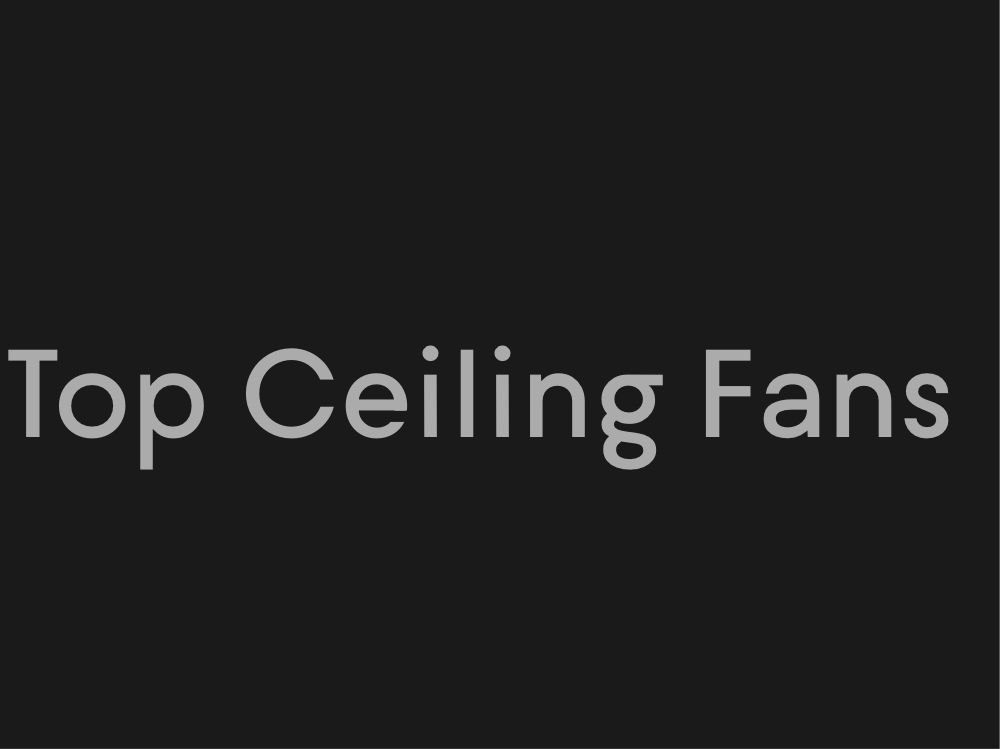Guides
When Were Ceiling Fans Invented?
Yearning for a cooler past? Discover the surprising origins of ceiling fans and how they revolutionized indoor comfort.

Electric ceiling fans, a crucial development in modern cooling technology, were invented by Philip Diehl in 1882. Diehl's adaptation of a sewing machine motor for efficiency and modern designs laid the foundation for the widespread integration of electric motors. His 1889 patent further revolutionized cooling technology. The fan's evolution from ancient methods to mechanized models underscores its importance in maintaining indoor comfort. Understanding the history and advancements of ceiling fans can offer valuable insights for selecting the most suitable cooling solutions.
Key Takeaways
- Electric ceiling fans invented by Philip Diehl in 1882.
- Diehl adapted a sewing machine motor for efficiency and modern designs.
- Diehl's 1889 patent revolutionized cooling technology.
- Foundation for widespread adoption of electric motors.
- Significance of Diehl's invention in the evolution of fan technology.
Evolution of Cooling Technology
Revolutionizing cooling technology, the invention of electric ceiling fans by Philip Diehl in 1882 marked a significant advancement in home comfort. Diehl's innovation paved the way for a more efficient and accessible way to circulate air, improving indoor air quality and providing relief during hot summer months. As the first electric ceiling fans gained popularity, they quickly became a staple in households, offering a cost-effective cooling solution.
The evolution of cooling technology through electric ceiling fans showcased a shift towards more convenient and effective methods of maintaining comfortable indoor environments. While early ceiling fans in the US relied on water streams and turbine systems, Diehl's invention propelled the industry forward, setting the stage for further advancements in cooling systems.
With the rise of air conditioners in the 1950s, the usage of ceiling fans declined in the US. However, the legacy of Philip Diehl's invention continues to influence modern cooling technologies, highlighting the enduring impact of electric ceiling fans on home comfort.
Pre-Ceiling Fan Cooling Methods
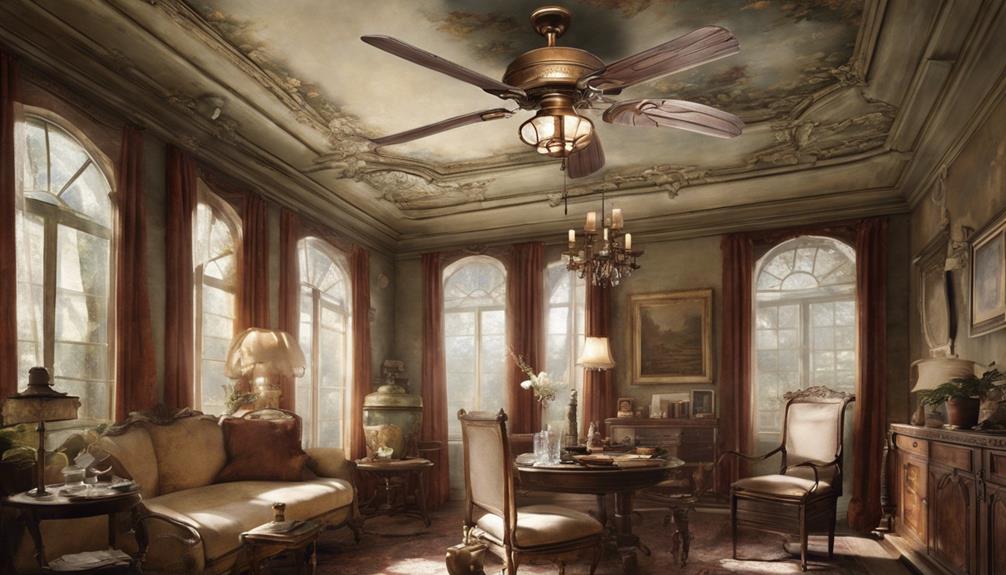
Before the invention of ceiling fans, various cooling methods were utilized throughout history to combat heat and improve comfort in indoor spaces.
- Ancient Egyptians: Around 4,000 BC, ancient Egyptians used palm leaves to fan themselves, creating a breeze for cooling purposes.
- Human-Powered Mechanized Fans: In 180 A.D., the Chinese developed human-powered mechanized fans, a significant advancement in cooling technology for that time period.
- Ice Blocks for Cooling: In the 1830s, a doctor in Florida employed ice blocks to cool patients. This method was primitive but effective in providing relief from the heat.
These methods were the predecessors to the modern ceiling fan and electric fan. The journey from manual methods to mechanized cooling devices like fans showcases our continuous quest for comfort and innovation.
It wasn't until Schuyler Skaats Wheeler created the first electric fan in 1882 that a new era of cooling technology began, paving the way for the groundbreaking invention of the ceiling fan by Philip H. Diehl in 1889.
Philip H. Diehls Invention
After exploring the evolution of cooling methods leading up to the creation of the first electric ceiling fan, Philip H. Diehl's inventive breakthrough in 1882 propelled the industry into a new era of comfort and efficiency. Diehl's genius was in adapting a sewing machine motor to power the first electric ceiling fan, revolutionizing how people cooled their living spaces.
This marked a significant shift from the water or steam-powered fans of the past. Diehl's invention not only brought about enhanced efficiency but also set the stage for modern ceiling fans as we know them today. The integration of electric motors in ceiling fans represented a monumental leap in cooling technology, making the devices more accessible and practical for everyday use.
Diehl's pioneering work laid the foundation for the widespread adoption of ceiling fans in homes and commercial establishments, shaping the way we think about indoor comfort and air circulation.
Significance of 1889 Patent
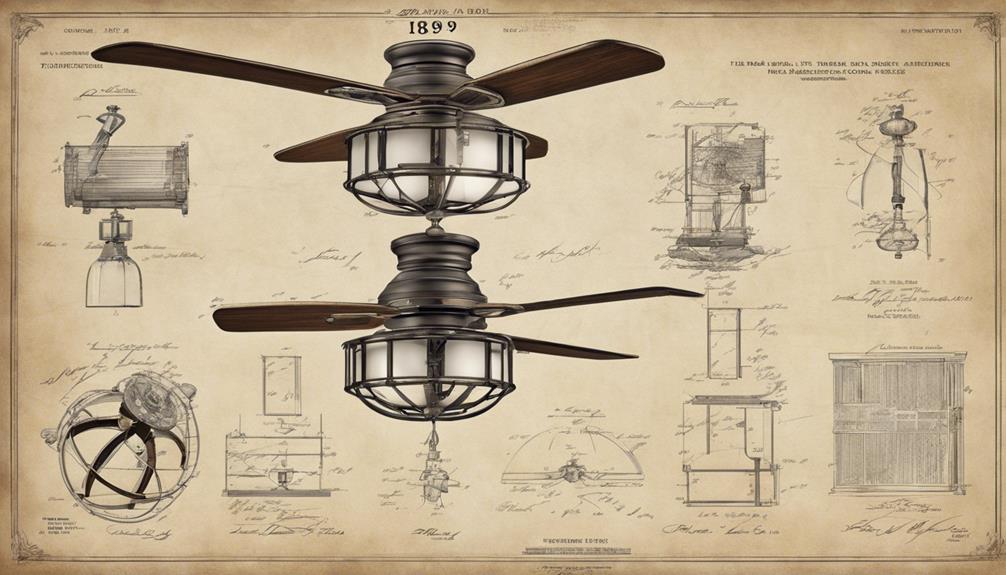
The 1889 patent for the ceiling fan by Philip H. Diehl was a game-changer in the world of cooling technology.
This innovation not only impacted the way fans were designed but also set a new standard for electric cooling systems.
Diehl's patent laid the foundation for the widespread use of electric ceiling fans in both residential and commercial spaces.
Patent Impact on Fans
Issued in 1889, Philip Diehl's ceiling fan patent revolutionized the fan industry by introducing electric ceiling fans to the market. The impact of this patent was immense, shaping the future of fan technology and design.
Here are three ways Diehl's patent influenced the world of fans:
- Introduction of Electric Ceiling Fans: Diehl's patent marked a significant shift from manual to electric-powered fans, making them more convenient and efficient.
- Modern Designs: The 1889 patent laid the foundation for the development of modern ceiling fan designs, leading to sleeker and more functional fan models.
- Revolutionized Fan Industry: Diehl's innovation set the stage for the widespread adoption of electric ceiling fans, transforming how people cooled their homes.
Innovation in Cooling
Having revolutionized the way homes were cooled, Philip H. Diehl's 1889 patent for the ceiling fan integrated electric motors, ushering in a new era of efficient cooling systems.
Before Diehl's invention, ceiling fans relied on manual systems or water and steam energy for operation. The incorporation of electric motors in the patent marked a significant advancement in household comfort and technology.
This innovation not only improved the effectiveness of cooling but also laid the foundation for modern advancements in home cooling systems. Diehl's contribution with the ceiling fan and electric motor integration transformed the way we think about cooling our living spaces, making it more convenient and accessible for everyone.
The 1889 patent truly revolutionized the cooling industry, enhancing the quality of life for many.
Advancements in Fan Technology
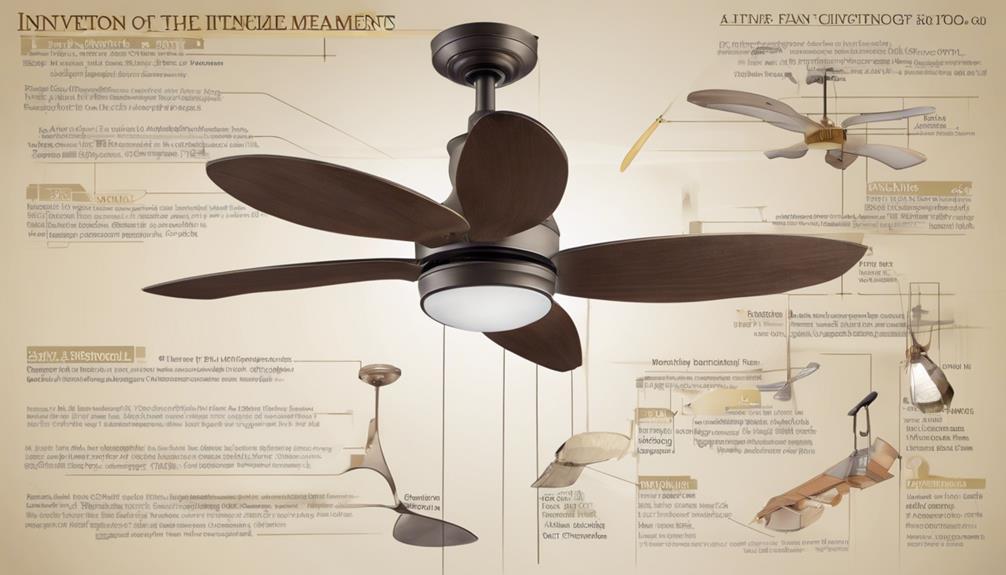
Ceiling fan technology has come a long way since its inception in 1882. Fan designs have evolved significantly, incorporating features like adjustable speeds, remote controls, and even smart home integration.
Energy efficiency improvements have also been a key focus, with modern fans using less power while providing the same cooling effect.
Fan Design Evolution
Evolution in fan design technology has propelled the functionality and convenience of ceiling fans since the introduction of the first electric ceiling fan by Philip Diehl in 1882. These advancements have transformed the way we use and interact with ceiling fans, making them more efficient and user-friendly. Some notable developments include:
- Incorporation of remote controls: Modern ceiling fans now often come equipped with remote controls, allowing for easy operation from anywhere in the room.
- Introduction of reversible blade designs: The innovation of reversible blade designs enhances the fan's functionality, enabling users to adjust the airflow direction for different seasons.
- Integration of light fixtures: Many modern ceiling fans now feature integrated light fixtures, providing both illumination and air circulation in one convenient unit.
Energy Efficiency Improvements
As fan design technology has advanced, particularly with the introduction of BLDC motors, significant improvements in energy efficiency have revolutionized the operation of modern ceiling fans. BLDC motors consume less power than traditional induction motors, leading to reduced power consumption and enhanced sustainability.
These energy-efficient ceiling fans not only help lower electricity bills but also promote a quieter and more comfortable living environment. The evolution towards sustainable cooling solutions has propelled the development of modern ceiling fans that prioritize energy efficiency.
Home Comfort Revolution
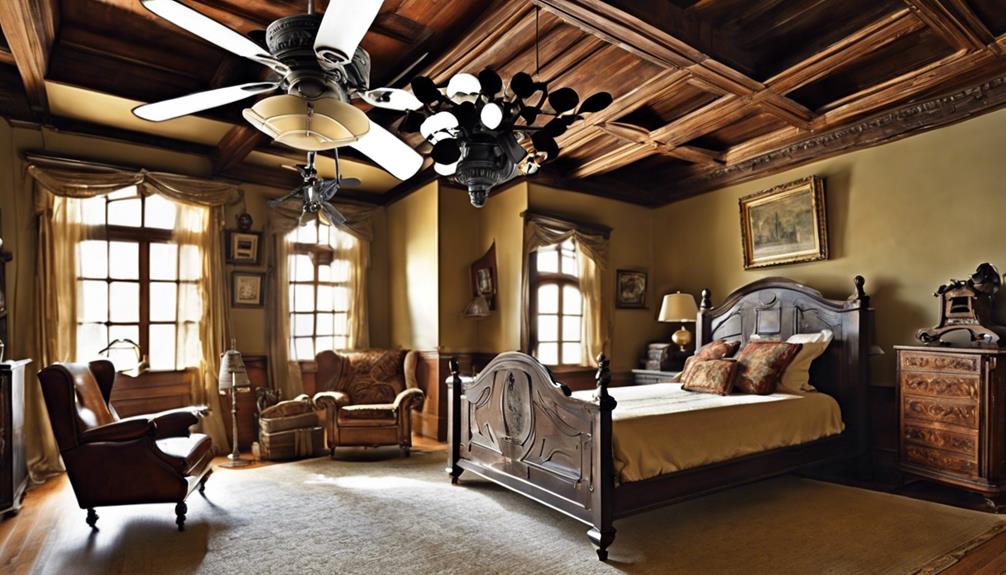
During the Home Comfort Revolution, innovations like the electric ceiling fan by Philip Diehl transformed the way we experience cooling in our homes. These ceiling fans appeared at a time when air conditioning wasn't widely available, helping alleviate the discomfort caused by the energy crisis. Here are three key points about the impact of the first ceiling fan:
- Affordable Cooling Solutions: In the 1920s, ceiling fans gained popularity as an affordable way to cool households, providing a much-needed respite from the heat.
- Crucial Air Circulation: Before the widespread use of air conditioning, ceiling fans played a crucial role in circulating air and maintaining a comfortable environment indoors.
- Continuous Improvement: Over time, the design and technology of ceiling fans continued to evolve, offering enhanced comfort and efficiency for homeowners seeking relief from the heat.
The evolution of ceiling fans reflects our ongoing quest for better home comfort solutions, showcasing how a simple invention can make a significant difference in our daily lives.
Efficiency of Ceiling Fans
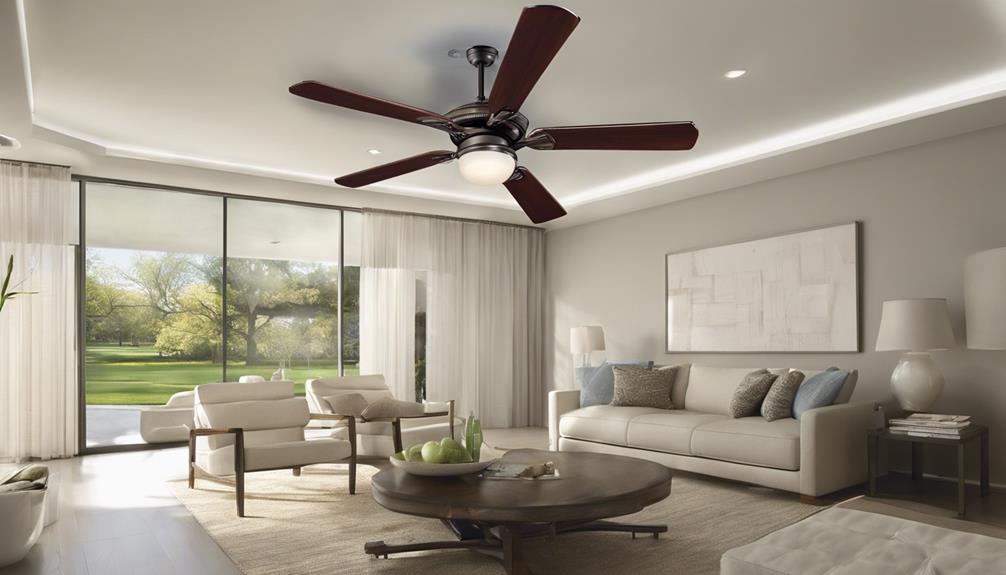
Ceiling fans' energy efficiency sets them apart as a cost-effective cooling solution compared to traditional air conditioning systems. While ceiling fans don't lower the air temperature, they create a cooling effect by circulating air and increasing airflow in a room. This can make you feel cooler without actually changing the temperature. What's impressive is that ceiling fans consume significantly less energy than air conditioning units, making them a more energy-efficient choice for keeping cool.
Additionally, ceiling fans can be multifunctional, serving as both cooling and lighting sources. Many ceiling fan models come with built-in light fixtures, offering a dual-purpose solution that can help save energy and reduce electricity costs. During colder months, ceiling fans can even be used to push down warm air trapped near the ceiling, helping to distribute heat more evenly throughout the room and potentially reducing the need for extra heating. This versatility and efficiency make ceiling fans a practical and economical choice for maintaining a comfortable living environment.
Widespread Cooling Solution
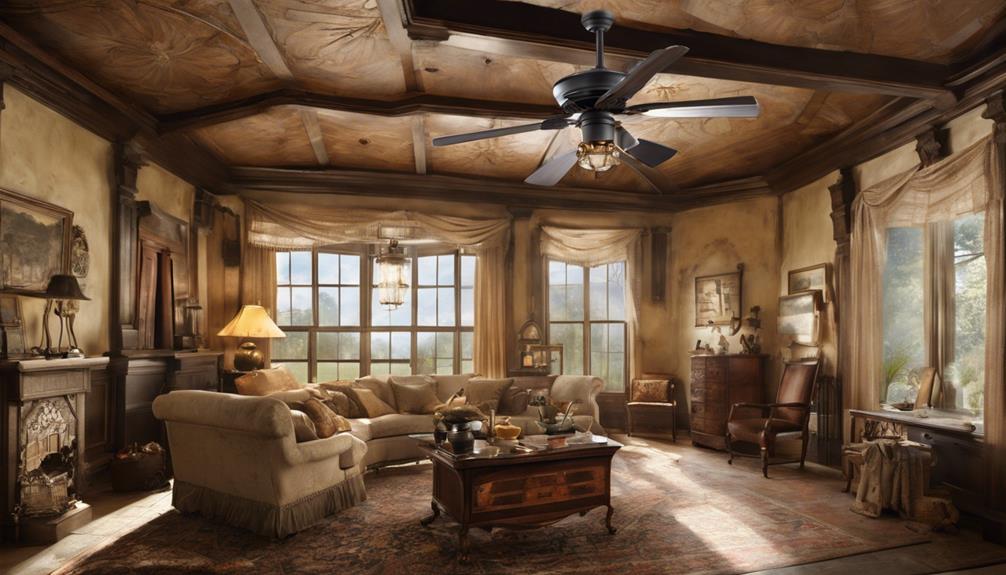
Efficiently revolutionizing the way spaces were cooled, the invention of electric ceiling fans by Philip Diehl in the 1880s paved the path for a widespread cooling solution that quickly gained popularity for its ability to circulate air and provide comfort in various environments. The integration of electric motors into ceiling fans marked a significant shift towards more efficient and affordable cooling solutions.
Here are three key reasons why electric ceiling fans became a favored choice for cooling:
- Energy Efficiency: Electric ceiling fans are known for their energy efficiency, consuming much less electricity compared to air conditioning units, making them a cost-effective cooling solution.
- Versatile Cooling: These fans are versatile in their ability to circulate air effectively, providing comfort in both residential and industrial settings, catering to a wide range of cooling needs.
- Affordability: Electric ceiling fans are an affordable option for maintaining a comfortable environment, offering a budget-friendly cooling solution for many households and businesses.
Impact on Household Cooling
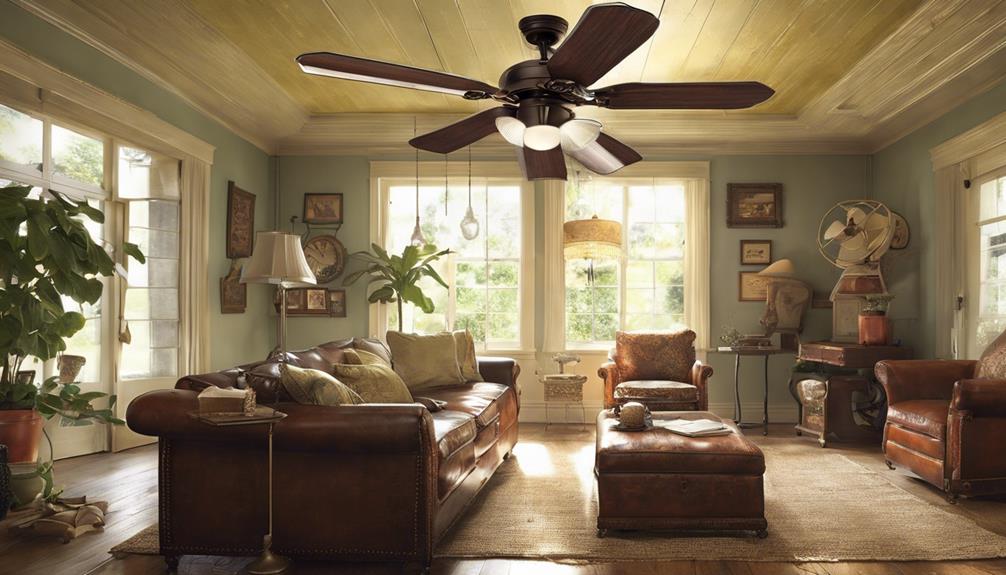
Ceiling fans have been a game-changer for household cooling, providing energy-efficient solutions that improve indoor air circulation. They're a cost-effective option for maintaining a comfortable environment while reducing electricity consumption.
As technology advances, the development of energy-efficient fan models aims to enhance cooling efficiency and lower maintenance requirements.
Energy-Efficient Cooling Solution
Revolutionizing household cooling solutions, ceiling fans have significantly impacted energy consumption and cost savings.
- Energy Efficiency: Ceiling fans are known for their energy-efficient operation, consuming only a fraction of the energy compared to traditional air conditioning units.
- BLDC Motors: The development of energy-efficient ceiling fans with Brushless DC (BLDC) motors has further enhanced their efficiency, reducing electricity consumption in households.
- Cost-Effectiveness: In regions like India with hot climates, ceiling fans are a popular choice for primary cooling due to their cost-effectiveness, providing practical cooling benefits while saving on energy costs.
Ceiling fans, equipped with advanced technologies like BLDC motors, offer a sustainable and budget-friendly solution for household cooling needs, ensuring comfort without compromising on energy efficiency.
Improving Indoor Air Circulation
Improving indoor air circulation can significantly enhance household cooling efficiency and comfort. Ceiling fans, invented in the 1880s, play a crucial role in maintaining a pleasant indoor environment. By circulating air and creating a gentle breeze, ceiling fans help occupants feel cooler without lowering the room temperature.
These energy-efficient devices are a cost-effective cooling solution for households. Proper placement and use of ceiling fans can optimize air circulation, making rooms feel more comfortable during hot weather. With their ability to complement air conditioning units or be used on their own, ceiling fans are a valuable addition to any household seeking efficient cooling solutions.
Cost-Effective Cooling Option
Introducing a cost-effective cooling option that has stood the test of time: the humble ceiling fan.
Ceiling fans were introduced in the late 19th century as a budget-friendly way to cool households. They're energy-efficient, consuming less power than air conditioning units. Despite technological advancements, ceiling fans remain popular for their affordability and effectiveness in providing comfort.
Many households globally rely on ceiling fans as a staple for residential cooling solutions.
Historical Context of Ceiling Fans
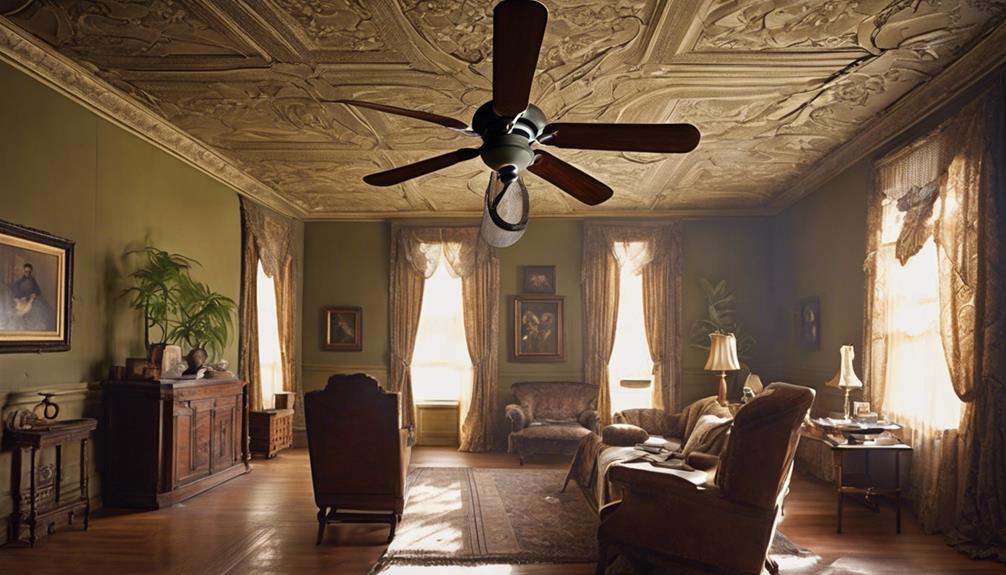
In the historical context of ceiling fans, the punkah style fans originating in India around 500 BC were manually operated. These early fans were simple yet effective, with individuals pulling a rope or cord to swing the fan back and forth, providing a cooling breeze.
Fast forward to the 1860s in the United States, where the first rotary ceiling fans emerged, initially powered by water or steam energy. The introduction of electrically powered ceiling fans in 1882 by Philip Diehl marked a significant milestone, leading to the modern motor ceiling fan we're familiar with today.
As time progressed, ceiling fans became a common sight in the US, particularly in regions with hot climates such as the South. Despite the advent of air conditioning, countries like India continued to embrace ceiling fans due to their energy efficiency and effectiveness in circulating air. The legacy of the punkah style fan lives on in the design and function of modern ceiling fans, providing both comfort and style to homes worldwide.
Early Cooling Innovations
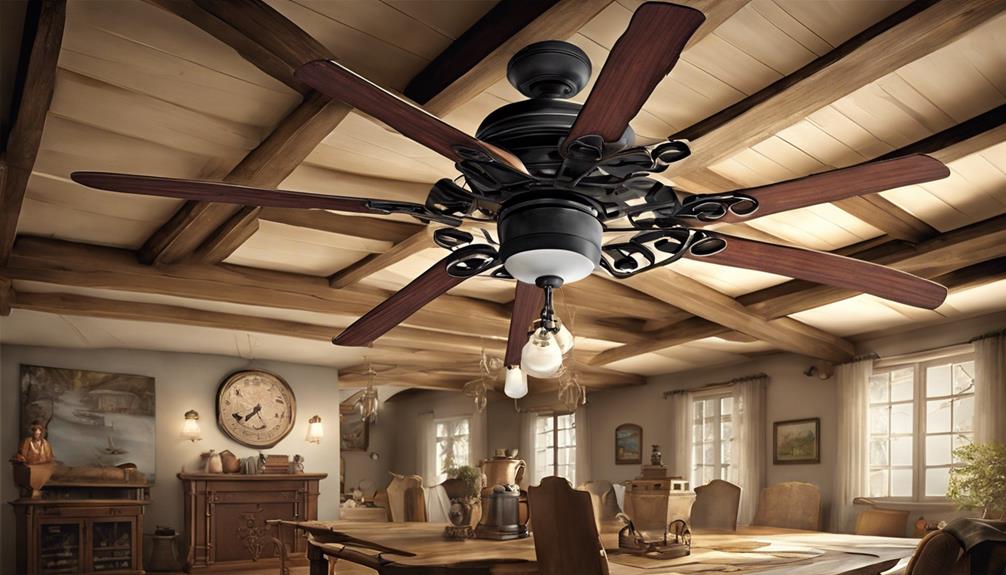
Moving from the historical context of ceiling fans to the realm of early cooling innovations reveals a fascinating evolution in the quest for efficient air circulation solutions.
- First Electrically Powered Ceiling Fan: The introduction of the first electrically powered ceiling fan by Philip Diehl in 1882 marked a significant milestone in the history of cooling innovations. This innovation paved the way for more convenient and effective air circulation in homes and workplaces.
- Two Blades Design: In the early 1860s, ceiling fans with two blades were developed in the US. These fans were powered by a water stream and turbine system, providing a rudimentary yet functional cooling solution for indoor spaces.
- Motor Ceiling Fan: The invention of the motor ceiling fan revolutionized the industry, offering improved performance and durability compared to earlier manual or water-powered designs. This innovation set the stage for the modern ceiling fan designs we use today.
Development of Fan Technology
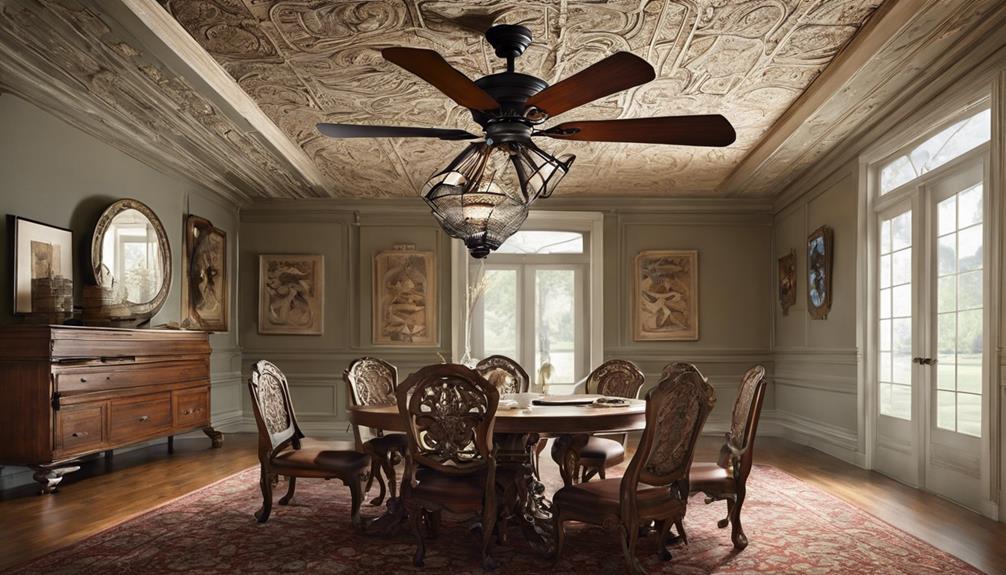
The evolution of fan technology has continually refined the efficiency and functionality of these cooling devices. From the early belt-operated systems in the 1860s to the groundbreaking electric ceiling fan by Philip Diehl in 1882, advancements in motor and electric technology have transformed the way we cool our spaces. In the 1920s, the shift to four-bladed fans improved performance and reduced noise levels, making them more appealing to consumers. However, the 1950s saw a decline in ceiling fan usage with the rise of air conditioning units.
To showcase the evolution of fan technology, consider the following table:
| Year | Technological Advancement |
|---|---|
| 1860s | Belt-operated rotary fans |
| 1882 | Invention of the electric ceiling fan with a sewing machine motor |
| 1920s | Transition to quieter and more efficient four-bladed fans |
| Present | Energy-efficient models with advanced motor technology |
These advancements highlight the continuous innovation in fan technology, leading to more energy-efficient models that cater to modern needs.
Consumer Options in Cooling
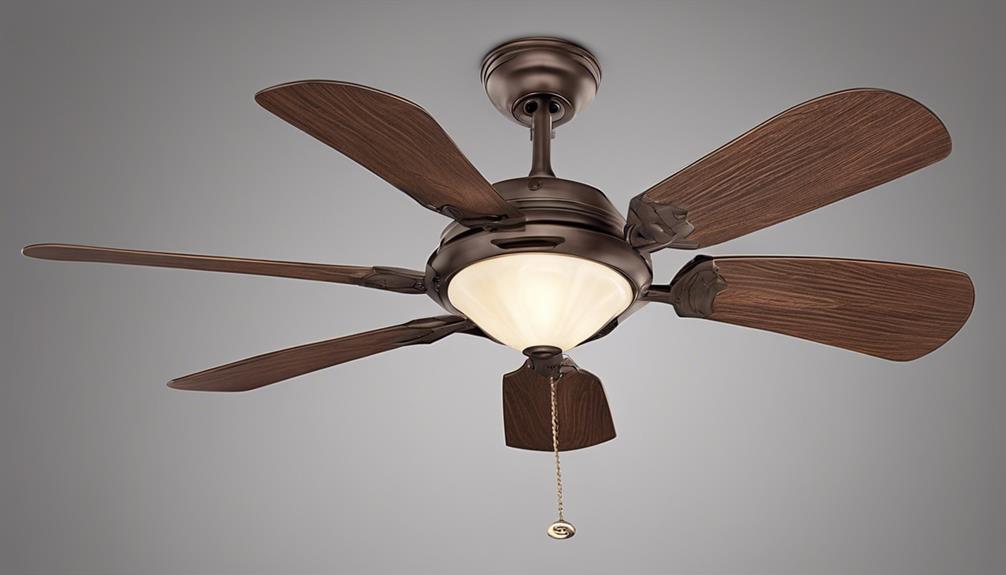
Exploring the diverse range of cooling options available to consumers reveals the versatility and functionality of modern ceiling fans. These innovative devices offer much more than just air circulation; they enhance the comfort and style of any room. Here are three key features that make modern ceiling fans a top choice for consumers:
- Variety of Designs: Modern ceiling fans come in a wide array of designs and styles, catering to different tastes and home aesthetics. Whether you prefer a sleek contemporary look or a more traditional feel, there's a ceiling fan to complement your decor.
- Reversible Blades: With reversible blades, these fans can be used not only for cooling in the summer but also for circulating warm air during the winter months. This feature adds to the efficiency and year-round usefulness of ceiling fans.
- Remote Control Functionality: Many modern ceiling fans are equipped with remote control capabilities, offering convenience and ease of use. Adjusting fan speed, changing direction, or turning on lights can all be done with the push of a button, enhancing the overall consumer experience.
Improving Indoor Temperatures
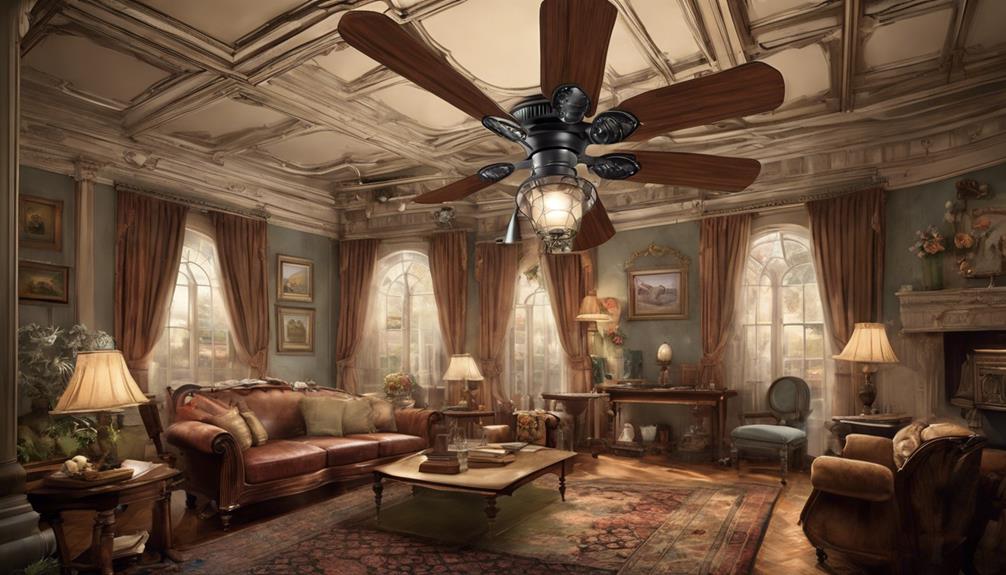
Enhancing indoor comfort through efficient temperature control methods can significantly improve the overall living experience. Indoor air circulation plays a crucial role in maintaining pleasant temperatures, and ceiling fans are a great way to achieve this.
Originally invented by Philip Diehl in the 1880s, ceiling fans were designed to increase air speed rather than lower air temperature. They create a cooling effect by aiding in sweat evaporation, making rooms feel more comfortable. Additionally, during winter, ceiling fans can help redistribute warmer air, reducing the need for excessive heating.
These energy-efficient devices have become popular for improving indoor temperatures while being environmentally friendly.
Frequently Asked Questions
What Did People Use Before Ceiling Fans?
Before ceiling fans, people relied on handheld fans for pre-electric cooling. They also utilized wind-powered ventilation, evaporative cooling methods, and mechanical air circulation systems.
These methods helped manage indoor temperatures before the invention of electric ceiling fans. The evolution of cooling technologies has provided more efficient and convenient ways to circulate air in homes and buildings, offering improved comfort and airflow.
Were There Ceiling Fans in the 1920s?
Oh, ceiling fans in the 1920s were a game-changer! Technological advancements took air circulation to new heights, making them not just a cooling solution but a trendy home decor essential.
The design evolution ensured they were both practical and stylish. It was like having a sleek breeze generator right in your living room!
Were There Ceiling Fans in the 60s?
In the 60s, ceiling fans were more than just retro design; they were an integral part of pop culture and interior trends. Despite advancing technology like air conditioning, ceiling fans remained a popular cooling solution in hot climates.
Companies like Hunter Fan and Westinghouse commercialized sales, making them accessible to many households. The 60s marked a period where ceiling fans continued to offer practical and cost-effective cooling solutions for homes.
When Did Fans Become Common?
Ceiling fans became common in residential properties due to their energy efficiency, air circulation benefits, design evolution, and modern technology. Popular models offered affordable cooling solutions, making them a staple in many households.
Despite the rise of air conditioners, ceiling fans remained popular, especially in hot climates like India. The continuous improvement in design and technology ensured that ceiling fans were and continue to be a crucial cooling system for many.
How Have Ceiling Fans Evolved from Traditional to Bladeless Designs?
Ceiling fans have come a long way, with bladeless ceiling fans gaining popularity in recent years. These modern designs have evolved from traditional models, offering a sleek and innovative alternative. By eliminating blades, these fans are not only safer but also more efficient and quieter, making them a popular choice for modern homes.
Conclusion
In conclusion, the invention of ceiling fans in 1889 revolutionized indoor cooling technology, making hot summer days bearable for households around the world.
Without ceiling fans, we'd be left sweltering in the heat, unable to escape the oppressive temperatures.
Thank goodness for the innovative minds that brought us this simple yet essential invention!
Guides
Energy Savings & Comfort: Benefits of Ceiling Fans
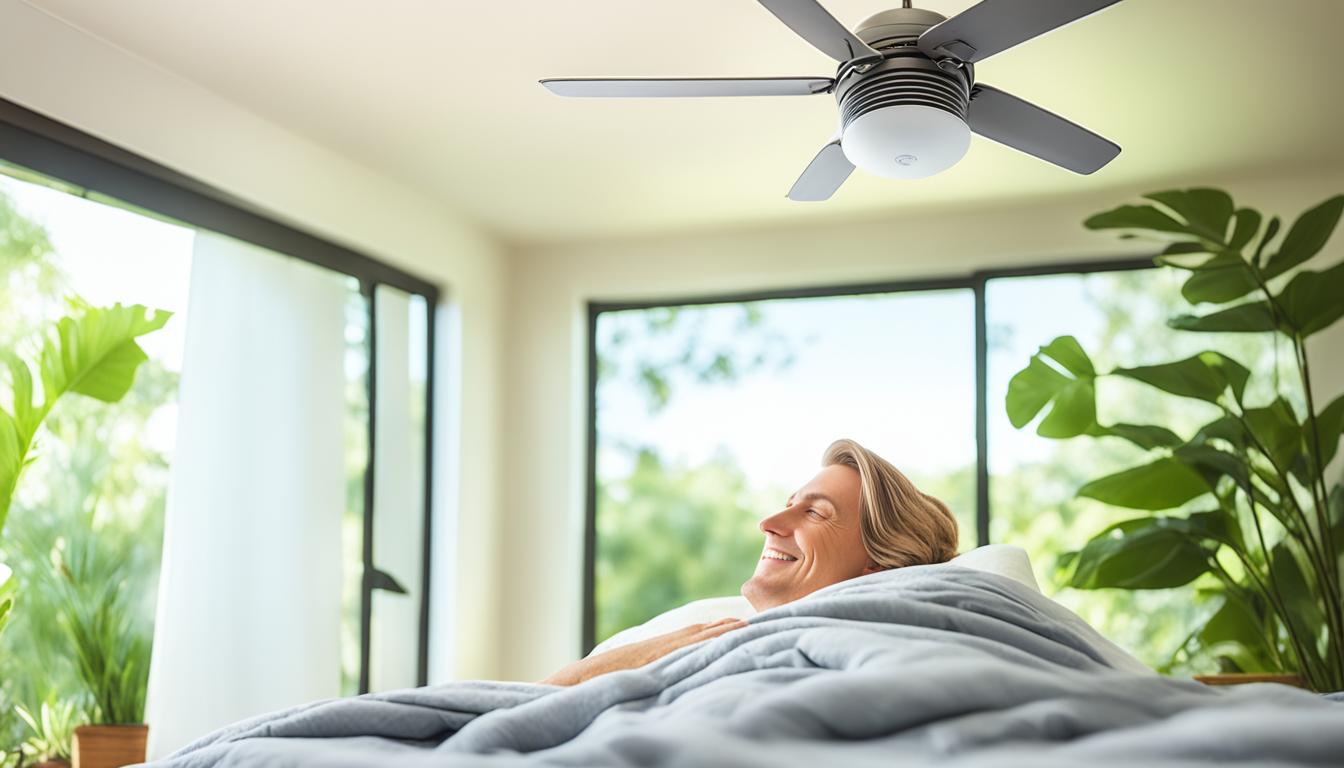
Did you know that modern Energy StarⓇ certified ceiling fans can increase the thermostat temperature by 4 degrees without compromising comfort? This surprising fact highlights the significant impact that ceiling fans can have on energy savings and indoor comfort. By using less energy than air conditioners and providing cost-effective cooling solutions, ceiling fans are becoming a popular choice for homeowners looking to reduce their energy consumption.
Key Takeaways:
- Ceiling fans can increase the thermostat temperature by 4 degrees without sacrificing comfort.
- Using ceiling fans in conjunction with air conditioners can result in significant energy savings.
- Modern ceiling fans have improved lifespan and energy-efficient features.
- Adding a light kit to your ceiling fan reduces overall energy consumption.
- Regular maintenance, such as dusting the fan blades, can maximize fan efficiency.
Cost Savings
Installing ceiling fans in the rooms where you spend most of your time can lead to significant cost savings on your energy bill. When compared to air conditioners, ceiling fans consume much less energy. While air conditioning can cost you approximately 36 cents per hour to operate, ceiling fans only cost about 1 cent per hour.
By using a ceiling fan in conjunction with your air conditioner, you can increase the thermostat temperature by 4 degrees without sacrificing comfort. This allows for energy savings and cost reductions, as you rely less on your air conditioner to cool your home.
Lower Energy Consumption
One of the key factors contributing to the cost savings of ceiling fans is their lower energy consumption compared to air conditioners. While air conditioners use a significant amount of energy to cool the air in your home, ceiling fans operate using a fraction of that energy.
“Ceiling fans can provide a cost-effective alternative to air conditioners, helping you save on your energy bills without compromising your indoor comfort.” – Energy Efficiency Expert
Increased Thermostat Temperature
Using a ceiling fan in conjunction with your air conditioner allows you to raise the thermostat temperature by 4 degrees without sacrificing comfort. This means that instead of keeping your air conditioner running at a lower temperature, you can rely on the cooling breeze of the ceiling fan to maintain a comfortable environment.
By raising the thermostat temperature, you can significantly reduce your energy consumption and lower your cooling costs.
Improved Lifespan
Updating to a new indoor ceiling fan ensures you have the most energy-efficient model available. Modern ceiling fans take advantage of advancements in materials, technology, and efficiency. They are available in both alternating current (AC) and direct current (DC) motors, with DC motors being more efficient. Additionally, modern fans are engineered and manufactured with sustainability in mind, helping to reduce wasted energy and maximize their lifespan.
These energy-efficient models incorporate durable materials and innovative technologies to enhance their longevity. For instance, some fans feature blades made from sustainable materials such as bamboo or recycled wood, ensuring both environmental and functional benefits. The use of high-quality bearings, advanced motor systems, and aerodynamic designs contributes to improved lifespan and optimal performance.
Investing in a ceiling fan with an extended lifespan not only enhances your indoor comfort but also promotes sustainability by reducing the need for frequent replacements. By choosing energy-efficient models, you not only save on utility costs but also contribute to the preservation of natural resources.
The Benefits of DC Motors
One notable advancement in modern ceiling fans is the use of direct current (DC) motors. Compared to traditional alternating current (AC) motors, DC motors offer enhanced energy efficiency and improved performance.
DC motors consume less electricity, resulting in significant energy savings over time. They are up to 70% more efficient than their AC counterparts, making them an excellent choice for environmentally conscious homeowners. These motors operate quietly, also adding to the overall comfort of your space.
Furthermore, DC motors feature advanced controls that allow for greater customization. Many models come with multiple speed settings, allowing you to select the ideal airflow for your needs. Some ceiling fans even offer smart controls, enabling you to adjust fan settings remotely from your smartphone or other devices.
Overall, the use of DC motors in energy-efficient ceiling fans provides a multitude of benefits, including prolonged lifespan, reduced energy consumption, and advanced functionality.
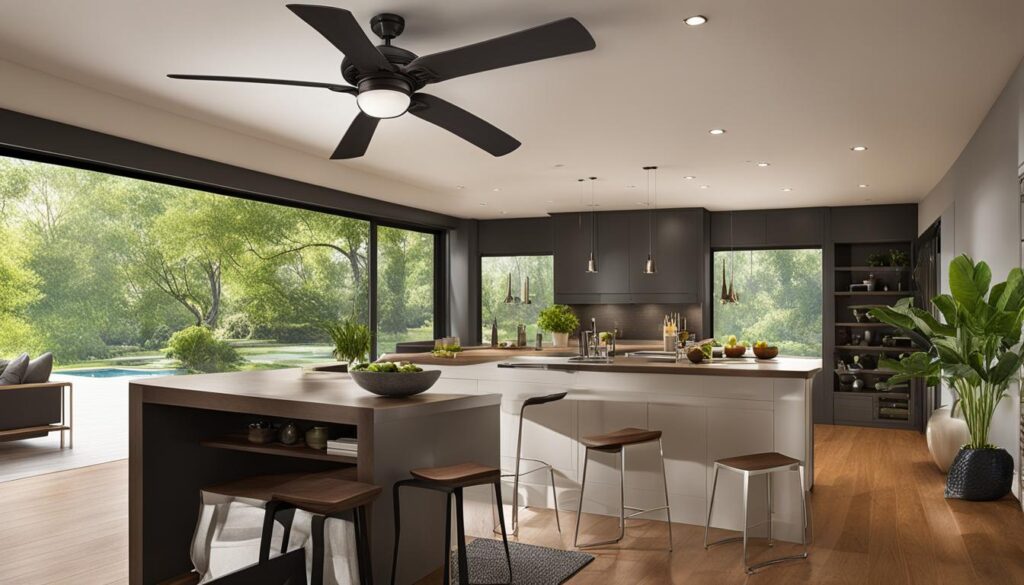
| Advantages of Energy-Efficient Ceiling Fans | Benefits |
|---|---|
| Improved Lifespan | Enhanced durability and longevity |
| Energy Efficiency | Significant reduction in energy consumption |
| Sustainability | Reduced environmental impact and resource conservation |
| Reduced Utility Costs | Savings on electricity bills |
| Enhanced Comfort | Improved airflow and adjustable speed settings |
More Effective Lighting
A well-lit room can enhance the overall ambiance and functionality of a space. By adding a light kit to your ceiling fan, you can centralize the lighting in a room and reduce overall energy consumption. This not only contributes to a more efficient and eco-friendly living environment but also provides various other benefits.
Energy-Saving Options

LED light kits are a popular choice when it comes to energy-saving options for ceiling fans. These kits often come with low-profile designs and long-lasting bulbs that consume significantly less energy compared to traditional incandescent bulbs. LED lights are not only environmentally friendly but also provide bright and efficient lighting for your space.
“LED light kits offer a cost-effective and sustainable solution for illuminating your room while reducing energy usage.”
Another energy-friendly option is fluorescent and compact fluorescent lights (CFLs). These light kits provide a variety of light temperatures, allowing you to customize the ambiance of your room. CFLs are known for their longevity and can last up to 10 times longer than traditional incandescent bulbs.
Flexibility in Lighting Selection
The ability to use fixtures with standard bulb bases offers flexibility in choosing the type of bulbs for your ceiling fan. Whether you prefer the energy efficiency of LED bulbs, the warm glow of incandescent bulbs, or the versatility of CFLs, you can easily find the right lighting option to suit your needs.
By centralizing the lighting with a light kit on your ceiling fan, you can effectively illuminate your space while reducing energy consumption. Whether you opt for LED, CFL, or incandescent bulbs, the variety of light temperatures available ensures that your room’s atmosphere is tailored to your preferences.
Making Your Fan as Efficient As Possible
To maximize fan efficiency, it’s important to turn off the fan when not in use to save power. By simply flipping the switch, you can conserve energy and reduce your electricity bill. Make it a habit to turn off the fan when you leave the room or when the temperature is already comfortable.
Dusting the fan blades is another essential maintenance step for keeping your fan running efficiently. Dust buildup on the blades can create drag, reducing the airflow and overall performance of the fan. To prevent this, it’s recommended to dust the fan blades at least once a week. You can use a duster, a vacuum cleaner attachment, or even an old pillowcase to collect the dust effectively.
Regularly dusting the fan blades not only helps to improve fan efficiency, but it also ensures clean air circulation in your space. Dust particles can accumulate on the blades, and when the fan is turned on, it can disperse these particles throughout the room. By keeping the blades clean, you can maintain good indoor air quality and reduce the risk of allergies or respiratory issues.
“Turning off the fan when not in use and dusting the blades are simple yet effective ways to optimize fan efficiency. By incorporating these maintenance tips into your routine, you can ensure that your ceiling fan operates at its highest efficiency, providing you with cool comfort and energy savings.”
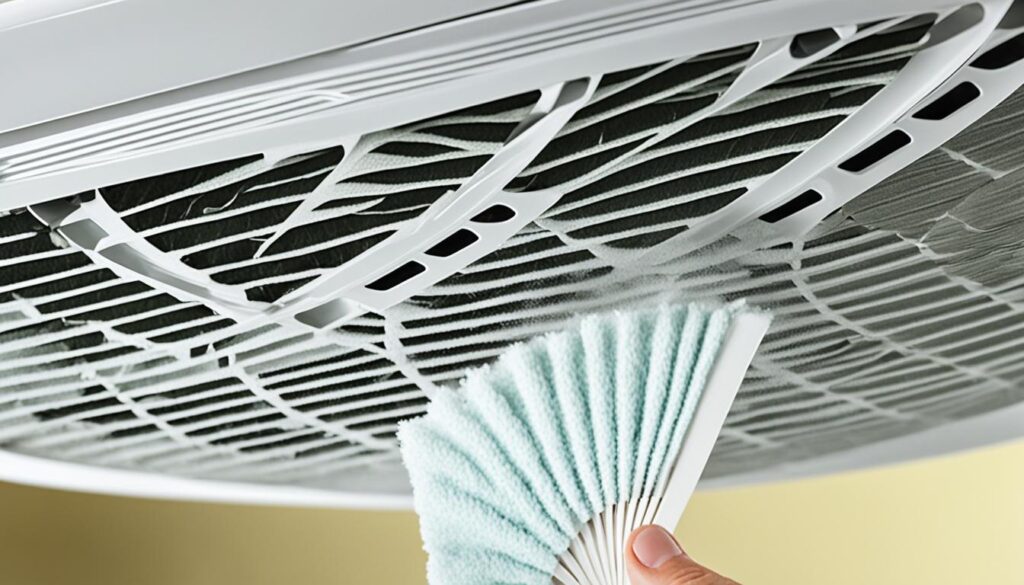
Remember, a well-maintained fan not only keeps you comfortable but also helps to conserve energy and reduce your environmental impact. By making your fan as efficient as possible through regular dusting and turning off when not in use, you can enjoy the benefits of improved air circulation and energy savings.
Finding the Ideal Ceiling Fan
Choosing the right ceiling fan is essential for maximizing its energy-saving benefits. To make an informed decision, consider important factors such as blade span and motor size. These aspects can be challenging to determine without expert guidance, but they play a crucial role in the fan’s effectiveness and efficiency.
When it comes to blade span, a general rule of thumb is that larger rooms require larger fan blades. Abladespan between 50-60 inches is suitable for rooms over 400 square feet, while bladespan between 42-48 inches works well for rooms up to 350 square feet. For smaller spaces, a bladespan of 36 inches or less is preferable.
The motor size of a ceiling fan also contributes significantly to its performance. A larger motor can move more air efficiently, ensuring proper airflow circulation. Look for fans with high-quality motors that operate quietly and provide optimal performance.
Choosing the ideal ceiling fan for your specific needs can be overwhelming. That’s why seeking guidance from experts is highly recommended. Dan’s Fan City, a reputable name in the industry, offers expert advice to help you make an informed decision. Their knowledgeable team of professionals can guide you through different fan options, including blade span, motor selection, and design choices.
By consulting experts, you can enhance your space, reduce your carbon footprint, and choose the perfect ceiling fan that meets your needs and preferences.
| Room Size (in square feet) | Ideal Blade Span (in inches) | Ideal Motor Size |
|---|---|---|
| Less than 150 | 36 or less | Small |
| 150-350 | 42-48 | Medium |
| Above 350 | 50-60 | Large |
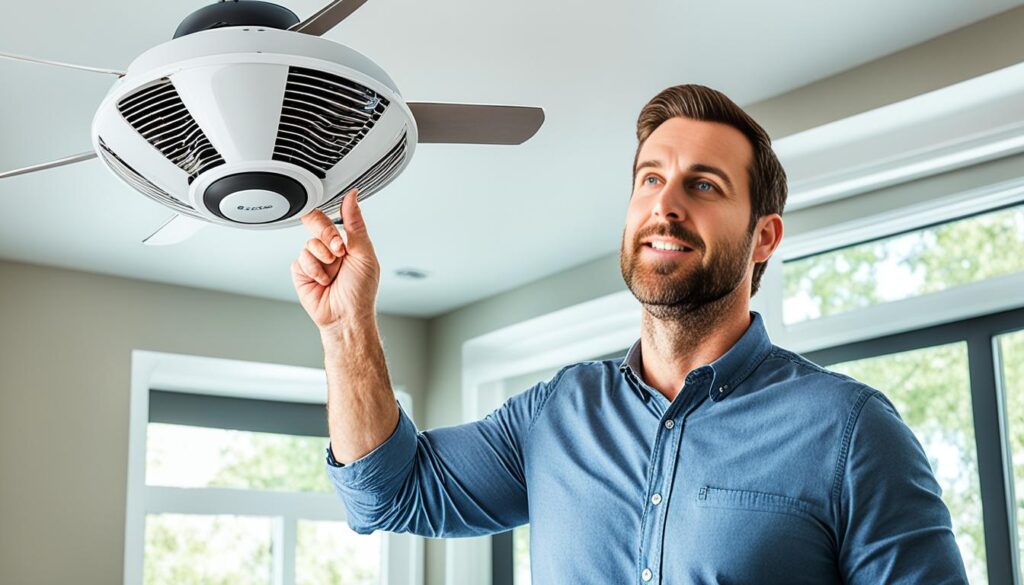
Do Ceiling Fans Help Air Conditioning Efficiency?
When it comes to maximizing air conditioning efficiency, ceiling fans play a crucial role. By setting your ceiling fans to the correct direction, you can significantly improve the performance of your air conditioner. During the summer months, it’s important to ensure that your ceiling fans rotate counterclockwise to create a downward draft and circulate cool air throughout the room.
By using ceiling fans in conjunction with your air conditioner, you can raise the thermostat temperature by up to 4 degrees while still enjoying the same level of comfort. This may not sound like much, but it can lead to substantial energy savings and a lower monthly cooling bill.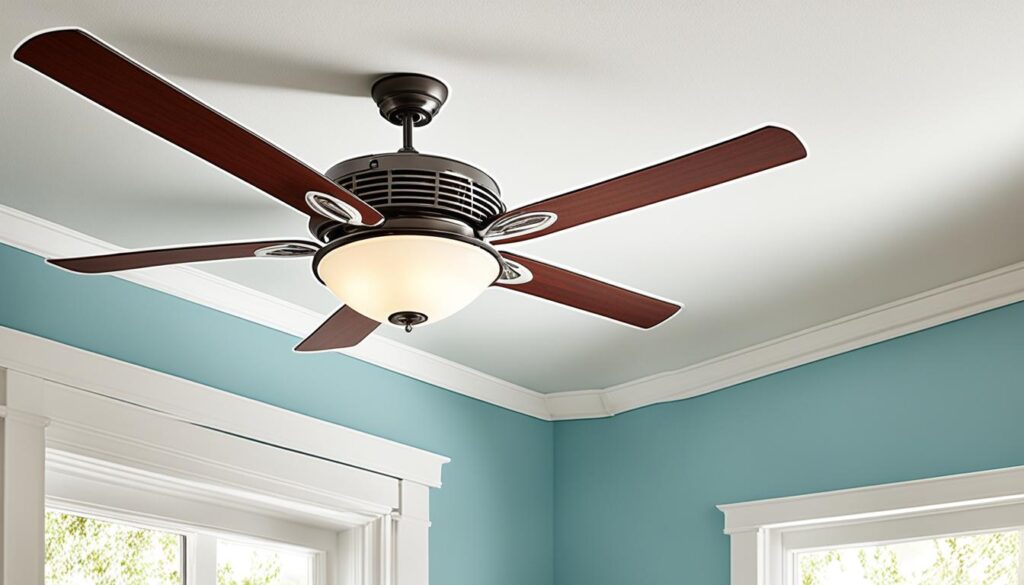
When the ceiling fan rotates counterclockwise, it creates a breeze that enhances the cooling effect of your air conditioner. The airflow from the fan helps distribute the cool air more effectively, preventing it from stratifying near the ceiling and ensuring that it reaches all corners of the room. This consistent circulation of cool air allows the air conditioner to work more efficiently, as it doesn’t have to struggle to cool down an entire space.
Running your ceiling fan and air conditioner simultaneously also helps reduce energy consumption. The fan’s cooling breeze creates a wind chill effect on your skin, making you feel cooler even when the thermostat is set at a higher temperature. By relying on the ceiling fan to provide personal comfort, you can use your air conditioner less frequently and lower your energy usage.
“Using ceiling fans in the correct direction can significantly improve the performance of your air conditioner and help you save on energy costs.” – Energy Efficiency Expert
It’s important to note that ceiling fans are not meant to cool the air, but rather to create a comfortable environment by improving air circulation and creating a cooling sensation on your skin. By using ceiling fans in the summer and raising your thermostat temperature, you can achieve a balance between energy savings and indoor comfort.
When the colder months arrive, you can reverse the direction of your ceiling fans to clockwise. This creates an updraft that helps circulate warm air trapped near the ceiling, spreading it throughout the room and reducing the workload on your heating system. This simple adjustment allows you to maintain a comfortable temperature while potentially lowering your heating costs as well.
The Benefits of Using Ceiling Fans with Air Conditioners:
- Increased air conditioning efficiency
- Energy savings and lower monthly cooling bills
- Enhanced air circulation for more consistent cooling
- Reduced workload on the air conditioner
- Avoidance of overcooling by raising the thermostat temperature
By utilizing your ceiling fans properly, you can optimize your air conditioning efficiency, save on energy costs, and enjoy a comfortable indoor environment. So, make sure to adjust your ceiling fans to the correct direction and take advantage of their cooling benefits!
Do Ceiling Fans Help with Cooling Costs?
When it comes to reducing cooling costs, ceiling fans can be a game-changer. By using ceiling fans strategically, you can raise the thermostat setting while still keeping your home comfortable. According to the Department of Energy, a ceiling fan allows you to raise the thermostat by approximately 4 degrees Fahrenheit without sacrificing comfort. This means that instead of setting the thermostat lower and relying solely on air conditioning, you can set it at a higher temperature and let the ceiling fan’s wind chill effect make you feel cool.
In practical terms, this translates to significant energy savings and reduced cooling costs. By relying on the gentle breeze generated by a ceiling fan, you can lower your reliance on air conditioning, which is a major energy consumer in most households. This not only benefits your monthly utility bills but also helps to reduce your carbon footprint, contributing to a more sustainable environment.
Furthermore, using ceiling fans in conjunction with air conditioning allows you to attain the same level of comfort while using less energy. This combination creates a more balanced cooling effect throughout your home, preventing hot spots and reducing the need for excessive air conditioning usage. By optimizing airflow, ceiling fans help circulate cool air more efficiently, allowing your air conditioner to operate more effectively.
The Department of Energy Recommends
“A ceiling fan will allow you to raise the thermostat setting about 4°F with no reduction in comfort.”
So, if you’re looking to slash your cooling costs without compromising your comfort, consider incorporating ceiling fans into your home’s cooling strategy. By maximizing the use of ceiling fans and adjusting your thermostat accordingly, you can enjoy energy savings, reduced cooling costs, and a more sustainable approach to indoor cooling.
Conclusion
Ceiling fans offer numerous benefits that contribute to energy savings, cost reductions, and improved indoor comfort. These energy-efficient alternatives to air conditioners allow you to increase the thermostat temperature while still enjoying a cool and comfortable environment. By selecting the right ceiling fan and practicing proper maintenance, you can maximize its lifespan and enhance its energy-saving capabilities.
Installing ceiling fans in your home has a significant impact on energy efficiency. Not only do they consume less energy compared to traditional air conditioners, but they also provide an effective way to circulate cool air throughout the room. By utilizing ceiling fans, you can reduce your reliance on air conditioning units and decrease your energy consumption, resulting in substantial cost savings.
Furthermore, ceiling fans contribute to better indoor comfort by creating a gentle breeze that promotes airflow and reduces humidity. This airflow aids in evaporation, making you feel cooler and more comfortable without the need for excessive air conditioning. Take advantage of ceiling fan technology advancements, such as Energy StarⓇ certification, to ensure optimal performance and energy efficiency.
Incorporating ceiling fans into your home is a smart choice for enhancing energy efficiency and achieving a comfortable living environment all year round. With their combined benefits of energy savings, cost reductions, and improved indoor comfort, ceiling fans prove to be a reliable and sustainable solution for creating a pleasant atmosphere in your home.FAQ
What are the benefits of ceiling fans?
How can ceiling fans help with energy savings?
Do modern ceiling fans have an improved lifespan?
How can ceiling fans provide more effective lighting?
What can I do to make my ceiling fan more efficient?
How do I choose the right ceiling fan?
Do ceiling fans help improve air conditioning efficiency?
Can ceiling fans help with cooling costs?
What are the overall benefits of ceiling fans?
Guides
3 Reasons Why a Clicking Ceiling Fan Is Dangerous
Journey into the potential dangers of a clicking ceiling fan to uncover the hidden risks that could jeopardize your safety.
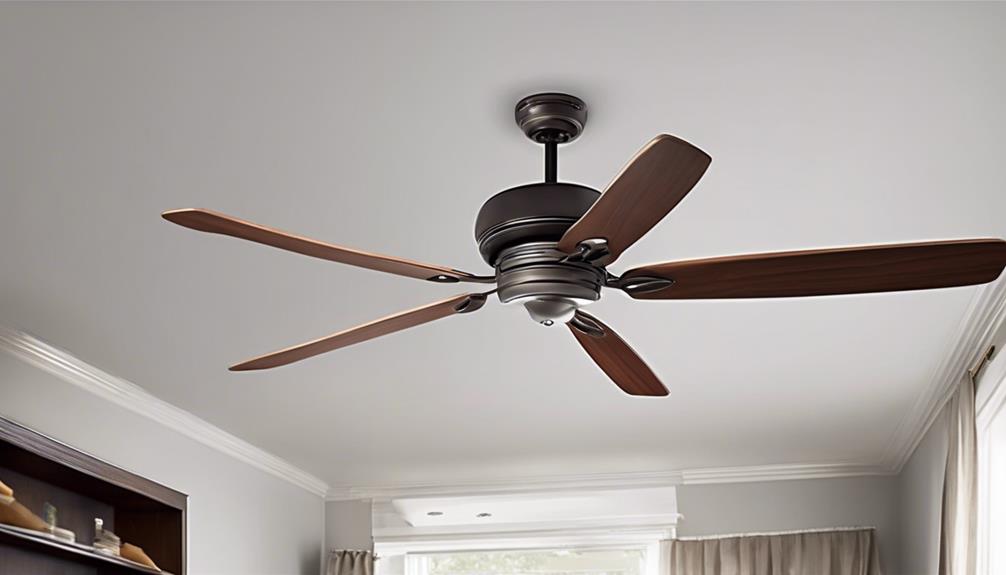
A clicking ceiling fan can be dangerous for three main reasons. Firstly, loose connections in the fan can lead to electrical hazards like short circuits and overheating, potentially causing malfunctions and motor strain. Secondly, damaged components indicated by the clicking noise can heighten the risk of fire due to overheating, sparks, and short circuits, emphasizing the importance of prompt attention to prevent serious malfunctions and fire outbreaks.
Lastly, misaligned blades not only reduce efficiency by creating uneven airflow, but they also increase the risk of fan detachment, potentially causing injury or damage. Taking immediate action to address these issues ensures safe operation, minimizes fire risks, and prolongs the fan's lifespan. Understanding these risks can help prevent accidents and ensure the safety of your home and family.
Key Takeaways
- Clicking indicates potential electrical issues like loose connections.
- Damaged components heighten fire risks in a clicking ceiling fan.
- Misaligned blades lead to uneven airflow and wobbling hazards.
- Prompt action prevents fire outbreaks and electrical hazards.
- Addressing issues promptly ensures safe operation and prolongs fan lifespan.
Potential Hazard: Loose Connections
Why are loose connections in a ceiling fan a critical concern for safety and functionality?
Loose connections in a ceiling fan pose significant electrical hazards, such as short circuits and overheating, which can lead to damage and malfunction. When the wiring in a ceiling fan isn't securely connected, it can disrupt the power supply, causing the fan to operate erratically and increasing the risk of a safety hazard. Additionally, loose connections may result in power fluctuations that strain the fan motor, potentially causing premature failure.
Addressing these loose connections promptly is crucial to prevent electrical accidents and ensure the safe operation of the ceiling fan. By securing these connections and ensuring a stable power supply, you can maintain the proper functioning of your ceiling fan and reduce the risk of any safety issues related to its operation. Taking these precautions will help you enjoy a comfortable and worry-free environment while using your ceiling fan.
Fire Risk: Damaged Components
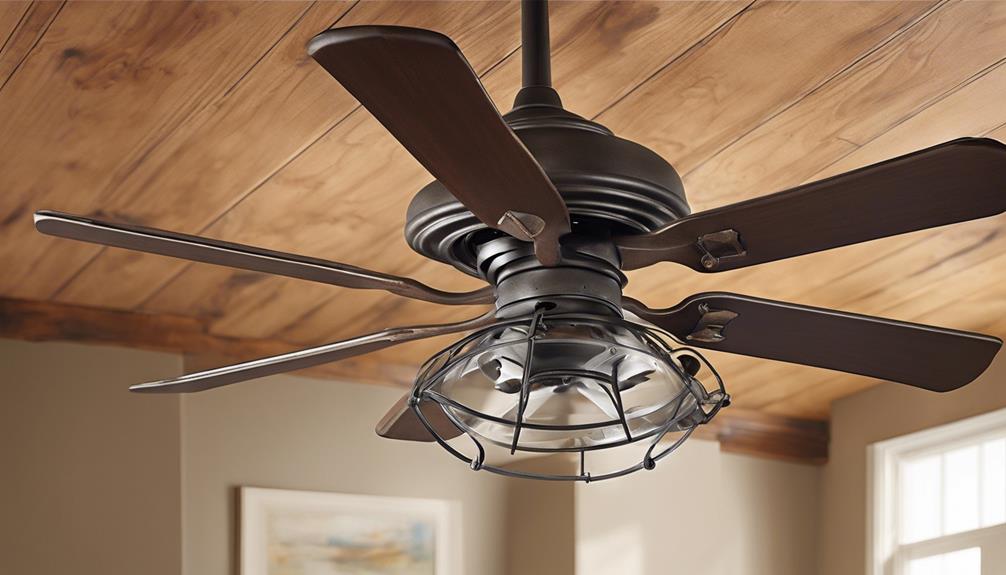
Damaged components in a clicking ceiling fan heighten the risk of fire due to potential electrical issues. When components like loose wiring or faulty connections create the clicking sound, they can lead to overheating, sparks, and even short circuits. Ignoring these warning signs may result in serious electrical malfunctions, posing safety hazards like fire outbreaks.
The continuous clicking noise serves as a crucial indicator of an underlying problem that could escalate into a dangerous situation if left unattended. Addressing these issues promptly is essential to prevent potential fire risks associated with damaged components in a ceiling fan. By taking action to repair or replace the faulty parts causing the clicking sound, you can mitigate the chances of electrical fires and ensure the safety of your home and loved ones.
Safety Concern: Misaligned Blades
Addressing misaligned blades promptly is crucial to ensure the safe operation of a ceiling fan and prevent potential hazards. Misaligned blades can lead to uneven airflow, reducing the fan's efficiency. Additionally, they can cause excessive wobbling, increasing the risk of the fan detaching from the ceiling. This wobbling may also result in the fan hitting the ceiling or other nearby objects, posing a safety hazard.
Moreover, misaligned blades can put stress on the motor and other components, potentially causing damage and malfunctions. It's essential to address misaligned blades promptly to prevent further issues and maintain the safety and functionality of the ceiling fan.
Regularly checking and adjusting the alignment of the blades can help ensure smooth and safe operation, prolonging the lifespan of the fan and minimizing risks associated with misalignment.
Frequently Asked Questions
Is a Clicking Ceiling Fan Dangerous?
Yes, a clicking ceiling fan can be dangerous. It may indicate loose parts that can lead to falling blades or light fixtures, posing a risk of injury. Additionally, loose connections could cause electrical hazards like shocks or short circuits.
To address this, prioritize fan maintenance, check for potential hazards, and seek professional inspection if needed. Safety precautions, electrical safety, and prompt repairs are crucial to prevent accidents and ensure a secure environment.
Is a Noisy Fan Dangerous?
A noisy fan can be dangerous due to potential underlying issues like loose components or electrical hazards. If left unaddressed, these problems may escalate, compromising the fan's safety.
Regular fan maintenance is crucial to prevent safety concerns caused by noise levels, electrical issues, wobbling blades, or motor problems. Seeking professional help for installation errors, blade balancing, or remote control malfunction can ensure a safe and functional fan.
Are you prioritizing fan maintenance for safety?
Why Is My Ceiling Fan Clicking?
When my ceiling fan starts clicking, it's usually a sign that something's loose or damaged. To address this, I check the fan's components, like blades and motor mountings, for any issues.
If I can't DIY fix it, seeking professional help is key to prevent safety hazards and keep the fan running smoothly.
Regular maintenance and timely repairs can reduce noise, ensure electrical safety, and extend the fan's lifespan.
Can a Noisy Ceiling Fan Fall Down?
A noisy ceiling fan can pose a safety risk if left unchecked. Loose components or faulty connections may compromise its stability, potentially causing it to fall. To prevent this, regular maintenance, prompt repairs, and ensuring secure installation are key safety precautions.
DIY fixes can help reduce noise, but professional inspections and repairs may be necessary. Considering the fan's weight and home insurance coverage is also important for maintaining a safe environment.
Is a Clicking Ceiling Fan a Sign of Potential Danger?
If your ceiling fan light flickers or if you hear a clicking sound, it could be a sign of potential danger. A clicking ceiling fan could indicate loose parts or electrical issues. It’s important to address these issues promptly to prevent any potential hazards.
Conclusion
In conclusion, a clicking ceiling fan can pose serious risks such as loose connections, fire hazards, and misaligned blades. It's important to address these issues promptly to ensure the safety of your home and family.
Regular maintenance and inspections can help prevent potential accidents and ensure your ceiling fan operates smoothly and safely. Remember, safety always comes first when it comes to electrical appliances.
Guides
Modernizing Your Space With Ceiling Fans
Amplify your living space's ambiance with the sleek and efficient touch of modern ceiling fans, transforming your room into a stylish oasis.

Enhance your living space with the modern touch of ceiling fans. Besides revamping your decor, these fans offer improved comfort, energy efficiency, and better air circulation. Factors like size, style, and proper installation are crucial when selecting a fan that matches your room aesthetics and preferences. Opt for energy-efficient models with adjustable speeds and reversible rotation for optimal cooling solutions. To delve deeper into optimizing your ceiling fan experience, consider exploring smart features, stylish designs, and customization ideas tailored to elevate both functionality and ambiance.
Key Takeaways
- Choose stylish designs like matte black or brushed nickel finishes for a modern look.
- Opt for smart features like voice control and remote access for enhanced convenience.
- Integrate lighting fixtures with dimmable options for ambient lighting.
- Consider customizable options like light kits and remote controls for dual functionality.
- Ensure energy efficiency by selecting Energy Star-rated fans with DC motors.
Benefits of Installing Ceiling Fans
Installing ceiling fans is a practical way to enhance your living space while improving comfort and energy efficiency. Modern ceiling fans not only add a touch of style to your room but also provide better air circulation, making the space more inviting. The energy-efficient nature of these fans helps in lowering electricity consumption and reducing utility costs, aligning with the desire for a more eco-friendly lifestyle. With improved lighting options, modern ceiling fans offer a blend of functionality and design, elevating the ambiance of any room.
Choosing to install a ceiling fan can transform the look and feel of a space, creating a more comfortable environment while also adding value to the room. The benefits of a ceiling fan go beyond just aesthetics, as they play a crucial role in enhancing airflow and reducing the need for constant air conditioning. By incorporating a modern and energy-efficient ceiling fan into your home, you not only improve the room's appeal but also contribute to a more sustainable and cost-effective living environment.
Factors to Consider Before Buying
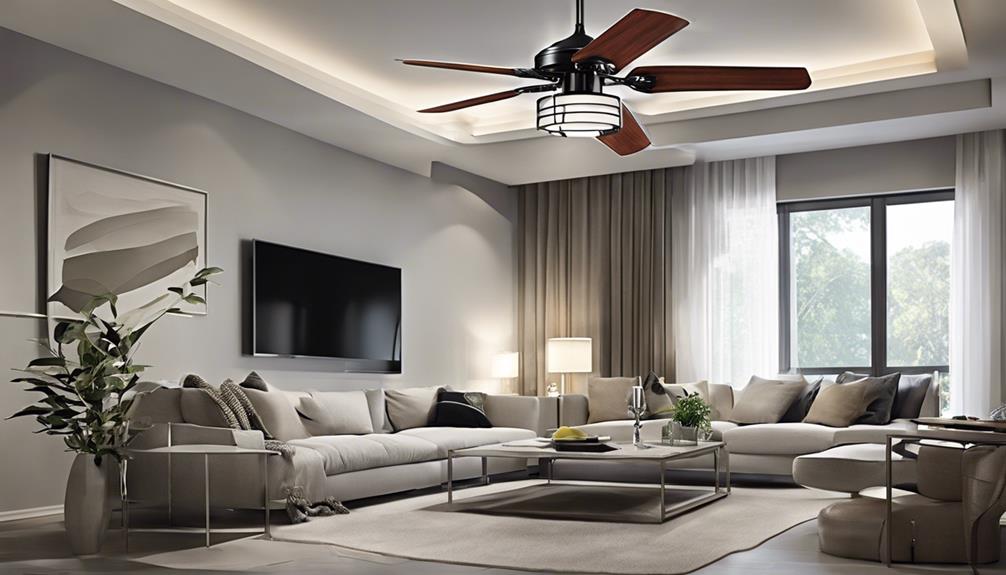
When considering purchasing a ceiling fan, it's important to think about the size and style that will complement your space.
Functionality and features such as adjustable speeds and reversible rotation can enhance comfort and energy efficiency.
Matching the fan to your room's decor and ensuring proper installation are key factors to keep in mind before making your purchase.
Size and Style
When choosing a ceiling fan, it's crucial to carefully consider both the size of the room and the style that will best complement your home decor theme. The fan blades, living room dimensions, and the matte black finish should all harmonize to create a cohesive look.
Make sure the fan size is proportionate to the room to avoid overpowering or underwhelming the space. Additionally, select a style that aligns with your existing decor, be it modern, rustic, traditional, or contemporary. By coordinating the ceiling fan design with your lighting fixtures, you can achieve a unified aesthetic.
Functionality and Features
To make an informed decision when purchasing a ceiling fan, it's essential to consider the functionality and features that align with your preferences and needs. Look for a ceiling fan with adjustable speeds to customize airflow and ensure comfort. Opt for models with integrated lights or the option to add light kits for added functionality and ambiance.
Additionally, choose a fan with reversible rotation for year-round use, promoting energy efficiency. It's crucial to select a ceiling fan that complements your room decor for a cohesive look while also considering energy-efficient options to reduce electricity consumption.
Energy-Efficient Ceiling Fan Options
When considering energy-efficient ceiling fan options, it's essential to look for models that offer adjustable speeds and reversible rotation for year-round comfort.
Investing in eco-friendly fan designs can help reduce electricity consumption and promote energy savings.
Cost-effective cooling solutions are also available in the form of energy-saving fan models that ensure optimal performance and efficiency in energy usage.
Energy-Saving Fan Models
Exploring energy-efficient ceiling fan options can significantly impact both your comfort and energy savings in your space. When considering energy-saving fan models, keep these points in mind:
- Adjustable Speeds: Opt for fans with adjustable speeds to tailor the airflow to your preferences, saving energy when less airflow is needed.
- Reversible Rotation: Look for fans with reversible rotation for both summer and winter use, maximizing efficiency throughout the year.
- Smart Fan Features: Consider smart fan options like those from Hunter that offer convenient control and additional energy-saving capabilities.
- Regular Maintenance: Ensure you clean and maintain your fan regularly to keep it running efficiently and effectively reduce energy consumption over time.
Investing in an energy-efficient ceiling fan can lead to long-term benefits for both your comfort and energy bills.
Eco-Friendly Fan Designs
Investing in energy-efficient ceiling fans offers a sustainable and cost-effective solution for enhancing your space while reducing electricity consumption. Many modern fans feature LED light fixtures, combining style with energy efficiency. Some eco-friendly fan designs carry the ENERGY STAR certification, ensuring top-notch energy efficiency standards.
By choosing an energy-efficient fan, you not only lower utility bills but also contribute to a greener home environment. These fans often come with adjustable speed settings and reversible rotation options for personalized comfort and efficiency.
Opting for an energy-efficient ceiling fan with an LED light fixture is a smart choice that benefits both your wallet and the planet, making it a win-win for a modern and eco-conscious lifestyle.
Cost-Effective Cooling Solutions
Considering the need for efficient cooling solutions, energy-efficient ceiling fans stand out as a cost-effective option to enhance comfort and reduce electricity usage. When looking for the perfect ceiling fan that also serves as a light fixture, consider these energy-efficient options:
- Energy Savings: Reduce electricity consumption and save on cooling costs.
- Adjustable Speeds and Reversible Rotation: Enjoy year-round comfort and increased energy efficiency.
- Smart Fan Features: Convenient control and additional energy-saving capabilities.
- Regular Maintenance: Ensure optimal performance and efficiency by keeping your fan clean and well-maintained.
Investing in a quality ceiling fan not only modernizes your space but also provides long-term functionality and energy-saving benefits. This article contains affiliate links for recommended ceiling fan products.
Stylish Designs for Modern Spaces

Enhancing the modern aesthetic of your space, stylish ceiling fan designs like Hunter's Park View model with its sleek matte black finish and three blades can elevate both indoor and outdoor areas. These fans not only provide excellent air circulation but also serve as chic additions to your home decor. The Park View fan comes with a convenient handheld remote for easy control over light, speed settings, and fan direction, ensuring a seamless user experience.
Here is a table showcasing some stylish ceiling fan designs perfect for modern spaces:
| Brand | Model | Features |
|---|---|---|
| Hunter | Park View | Matte black finish, 3 blades |
| Casablanca | Stealth | Brushed nickel, LED light kit |
| Minka Aire | Light Wave | Distressed Koa, 3 blades |
| Fanimation | Odyn | Matte Greige, 9 blades |
These fans boast Whisper Quiet and Wobble Free technology, guaranteeing a peaceful and stable operation that complements your contemporary living space.
Installation Tips and Tricks
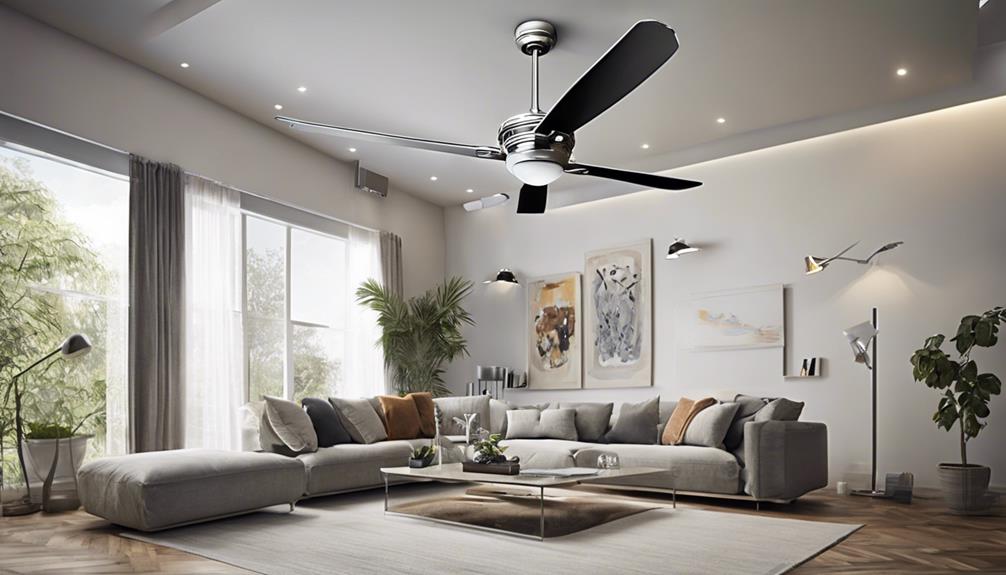
When it comes to installing ceiling fans, paying attention to fan placement tips and utilizing wiring simplification techniques can make the process smoother. These points will ensure that your ceiling fan isn't only installed correctly but also functions efficiently in your space.
Fan Placement Tips
To ensure optimal air circulation and efficiency, positioning the ceiling fan in the center of the room is crucial. When considering fan placement, remember these essential tips:
- Room aesthetics: Choose a fan that complements the room's style and color scheme for a cohesive look.
- Air circulation: Ensure the fan size matches the room size to maximize airflow and cooling effect.
- Temperature control: Adjust the fan direction based on the season to either cool or circulate warm air effectively.
- Ceiling height: Take into account the ceiling height when selecting a fan to prevent any installation complications.
Wiring Simplification Techniques
Positioning the ceiling fan correctly involves employing wiring simplification techniques for a smooth installation process. When working with the wires, it's crucial to use wire connectors to secure connections and prevent any electrical hazards.
Follow color-coding guidelines for wires to ensure everything is correctly connected and functions properly. Before starting the wiring process, always utilize a voltage tester to confirm that the power is off, ensuring your safety.
Neatly organizing and securing wires with cable ties not only maintains a clean appearance but also ensures a safe installation. If you encounter complex wiring issues or unfamiliar configurations, don't hesitate to consult a professional electrician for assistance.
Smart Ceiling Fan Features
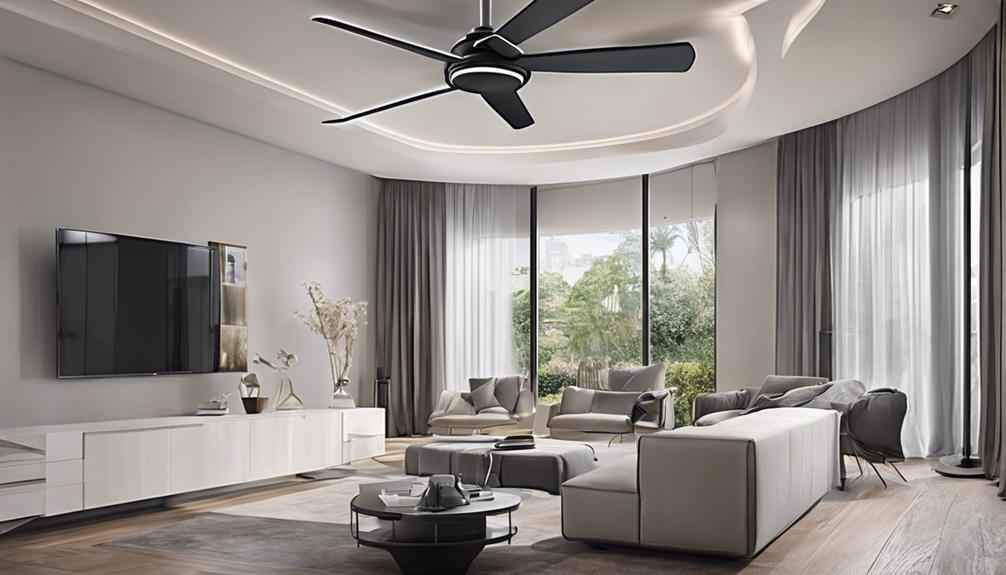
With smart ceiling fans, controlling your fan settings is as easy as a tap on your mobile device or a simple voice command. These modern features offer a seamless way to enhance your comfort and convenience while also promoting energy efficiency. Here's why smart ceiling fans are a must-have for any modern space:
- Voice control capabilities, customization options: Adjust your fan speed, direction, and lighting with just your voice, allowing for personalized settings tailored to your preferences.
- Smart technology integration, energy efficiency: Connect your fan to smart home systems for automated adjustments that help conserve energy and reduce utility costs.
- Temperature sensors, humidity control benefits: Enjoy a comfortable environment with advanced sensors that regulate temperature and humidity levels for optimal air quality.
- Remote access for convenience: Manage your fan settings from anywhere, ensuring your space is always at the perfect temperature for your needs.
Enhancing Room Ambiance With Lighting
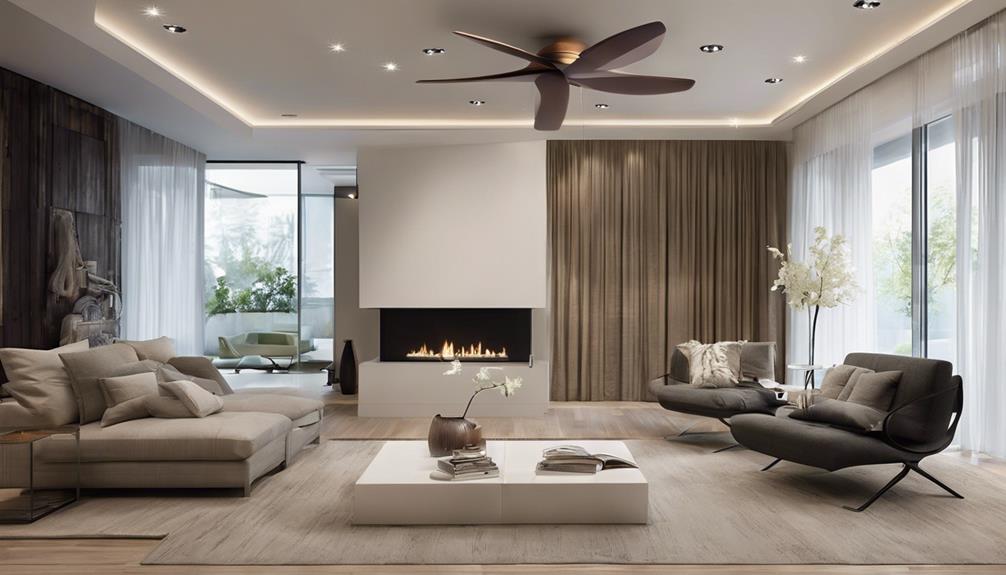
Creating a captivating ambiance in a room can be effortlessly achieved by incorporating lighting features on ceiling fans. Integrated lighting fixtures not only provide ambient lighting but also offer air circulation, merging functionality with style. With dimmable options, you can customize the brightness to suit your mood, enhancing the overall atmosphere of the space. Coordinating the fan's light fixture with existing room lighting can create a seamless and modern design, elevating the room's aesthetic appeal.
Ceiling fans with lighting kits offer versatility, serving as both a decorative and practical element in the room. By positioning the lighting properly, you can enhance the ambiance and mood, creating a well-lit and inviting environment for relaxation or entertainment. The combination of ambient lighting and air circulation contributes to a comfortable and welcoming space, where modern design meets functionality seamlessly.
Maintenance and Cleaning Tips
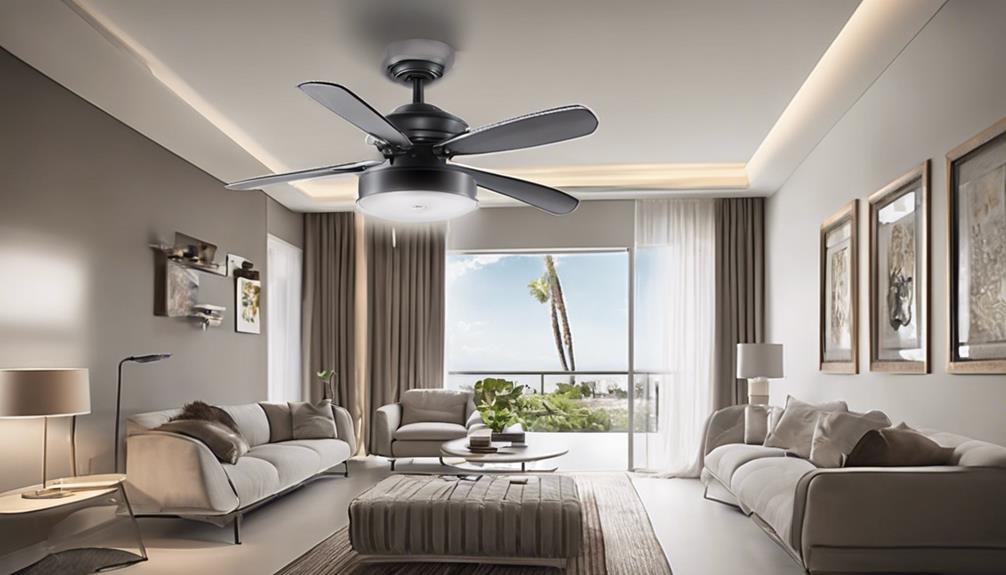
Regularly maintaining and cleaning your ceiling fan is essential to prevent dust buildup and ensure optimal performance. Here are some tips to keep your fan in top condition:
- Deep cleaning: Use a microfiber cloth or a vacuum cleaner with a brush attachment to gently clean the fan blades. This prevents dust accumulation that can affect the fan's efficiency.
- Motor maintenance: Check and tighten screws, bolts, and connections periodically to ensure the fan is securely installed. Additionally, lubricate the fan motor bearings following the manufacturer's recommendations to reduce friction and noise.
- Dust prevention: Regularly clean the fan blades and motor housing to prevent dust buildup and maintain optimal performance. This simple step can significantly extend the life of your ceiling fan.
- Professional maintenance: Consider professional maintenance services for thorough cleaning and inspection of internal components. This can help identify and address any potential issues before they become more significant problems, ensuring your fan lasts for years to come.
Ceiling Fan Placement Strategies
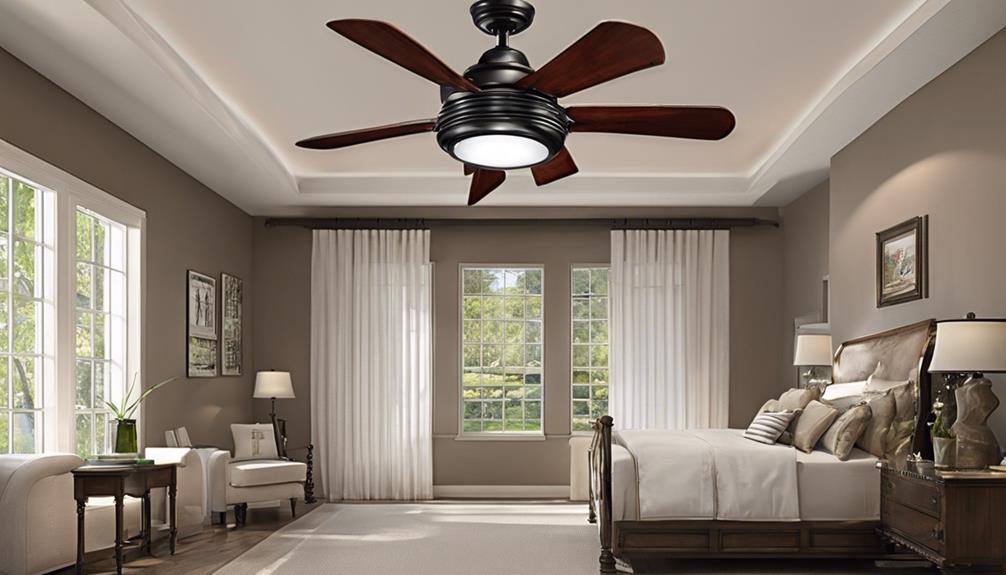
I always position ceiling fans in the center of a room for optimal air circulation. This placement ensures that the airflow reaches all corners, promoting room balance and maintaining a comfortable environment. When considering ceiling fan placement, it's crucial to factor in height considerations. A fan too close to the ceiling may disrupt airflow, while one hanging too low can be hazardous. To help visualize the importance of these strategies, refer to the table below:
| Ceiling Fan Placement Strategies |
|---|
| Position in the center of the room |
| Consider ceiling height |
| Ensure proper proportion to room size |
| Maintain room balance |
| Enhance both functionality and aesthetics |
Integrating Ceiling Fans With Smart Home Systems
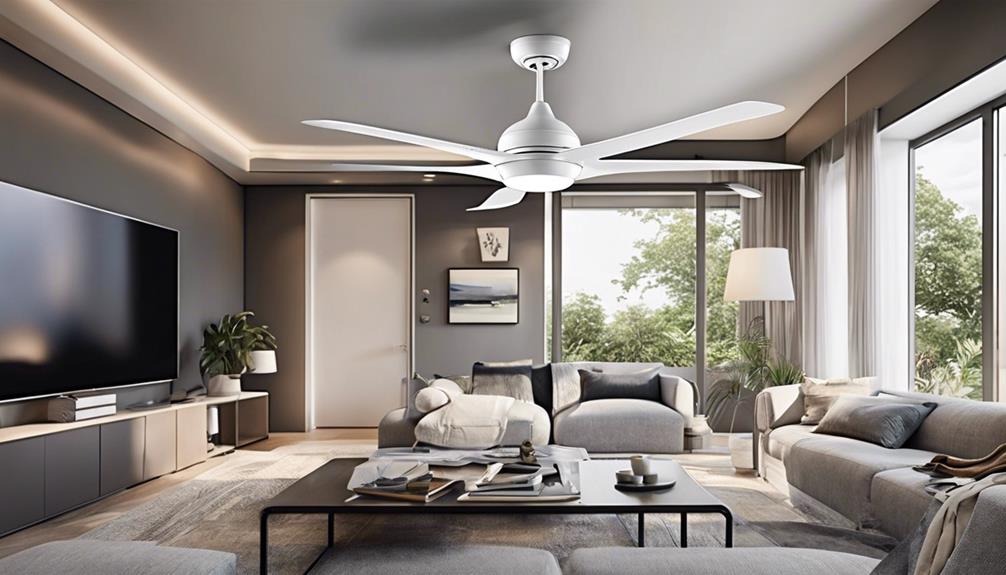
Positioning ceiling fans strategically not only optimizes airflow and maintains room balance but also opens the door to seamlessly integrate them with smart home systems for enhanced convenience and efficiency.
When considering smart integration for your ceiling fans, here are some key points to keep in mind:
- Compatibility: Ensure your smart ceiling fan can connect with popular smart home systems like Amazon Alexa, Google Assistant, or Apple HomeKit.
- Remote Control: Enjoy the convenience of adjusting fan speed, direction, and lighting from anywhere using smartphone apps.
- Scheduled Operations: Program your smart fan to operate based on specific schedules or conditions, enhancing both convenience and energy efficiency.
- Voice Commands: Take advantage of hands-free control by using voice commands to adjust your ceiling fan settings, contributing to a more connected and automated living environment.
Seasonal Use and Energy Savings
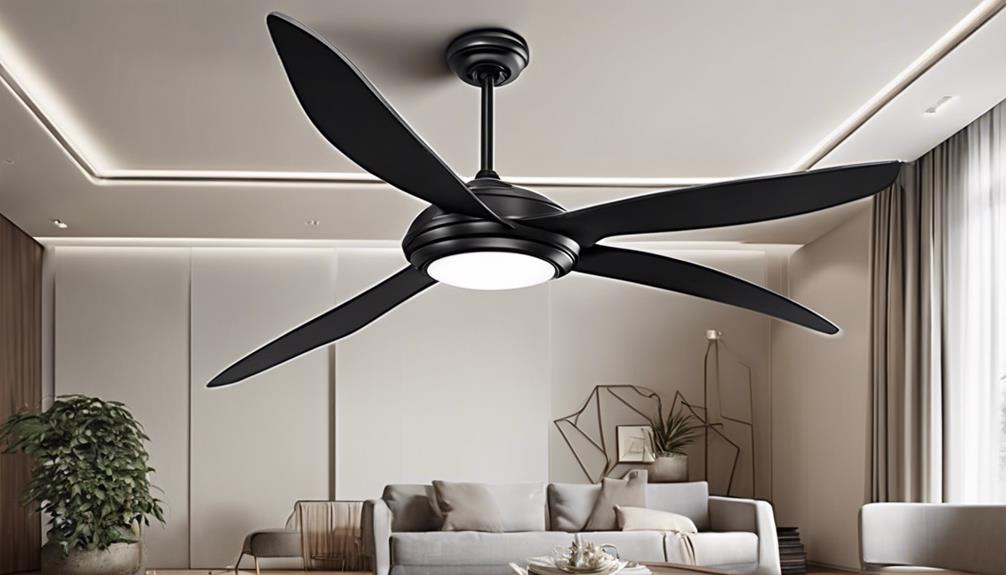
During seasonal changes, maximizing energy savings through strategic use of ceiling fans becomes paramount.
By adjusting the fan direction and speed based on the season, you can achieve seasonal efficiency and significant energy savings. In warmer months, running the fan counterclockwise at a higher speed helps with sustainable cooling and cost savings by creating a wind-chill effect, allowing you to raise the thermostat without sacrificing comfort. This practice can reduce your energy consumption and utility costs.
In contrast, during colder months, running the fan clockwise at a low speed helps distribute heat more evenly, aiding in temperature regulation and reducing the workload on your heating system. Combining the use of ceiling fans with your heating and cooling systems can result in up to 40% energy savings.
Investing in energy-efficient ceiling fans with LED lighting options further enhances these benefits, making it a smart choice for both comfort control and energy efficiency.
Unique Ways to Customize Ceiling Fans
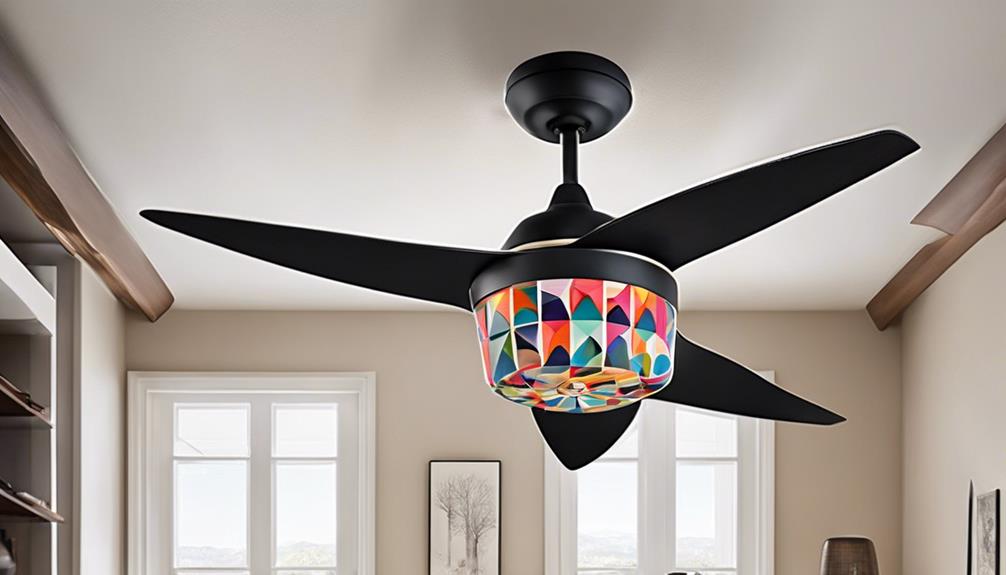
Maximizing the aesthetic appeal of ceiling fans can be achieved through unique customization options that elevate the fan's design and complement your space's overall theme. Here are some creative ways to personalize your ceiling fan:
- Enhance the fan with a wire-frame shade for an industrialist vibe.
- Upgrade the look by swapping out blades for retro-inspired wooden ones.
- Customize fan blades with washi tape and paint to add a burst of color and personality.
- Transform the appearance by painting it to complement the room's theme.
Adding personalized touches like stained wooden blades or faux paneling can offer unique upgrades that reflect your style and elevate the ambiance of your space. These customization ideas allow you to tailor your ceiling fan to suit your taste and create a truly one-of-a-kind look that enhances the overall aesthetic of your room.
Frequently Asked Questions
Do People Still Put Ceiling Fans in New Homes?
Yes, people still put ceiling fans in new homes. They offer energy efficiency benefits by reducing electricity consumption.
Design options include modern and stylish choices to enhance decor. Smart home integration allows for convenient control.
With 60% of new homes in the US featuring ceiling fans, they remain a popular choice for both functionality and aesthetics.
How Can I Make My Ceiling Fan More Modern?
To make my ceiling fan more modern, I can incorporate smart technology for convenience. I can choose a minimalist design for a sleek look and opt for energy-efficient features for cost savings. This combination won't only update the fan's functionality but also enhance the overall aesthetic of my space.
Where Not to Put Ceiling Fans?
I steer clear of putting ceiling fans in bathrooms due to potential water damage risks.
In kitchens, safety is paramount, so fans shouldn't disrupt cooking areas.
Bedrooms benefit from fan placement that complements decor without obstructing furniture.
It's important to consider these factors for optimal fan performance and longevity.
Is It Good to Have a Ceiling Fan in the Living Room?
Having a ceiling fan in the living room is a great idea. It can improve energy efficiency by helping with cooling and create a stylish design element. The fan provides both functional and aesthetic benefits, contributing to interior decor.
Additionally, modern ceiling fans come with remote control and smart technology for added convenience. Overall, a well-chosen ceiling fan can enhance the comfort and appeal of your living space.
Can Ceiling Fans Help Modernize and Reduce Radon Levels in a Space?
Ceiling fans don’t directly reduce radon levels, but they can help modernize and improve air circulation in a space. Proper air movement can disperse radon gas and improve overall air quality. Using ceiling fans in conjunction with radon mitigation systems can further enhance indoor air quality.
Conclusion
In conclusion, modernizing your space with ceiling fans can truly elevate the ambiance of any room.
With a wide range of benefits, styles, and energy-efficient options available, ceiling fans offer a practical and stylish solution for any home.
So, why not add a touch of elegance and functionality to your space with a sleek ceiling fan that will keep you cool and comfortable all year round?
Let your space soar to new heights with this stylish and practical addition.
-
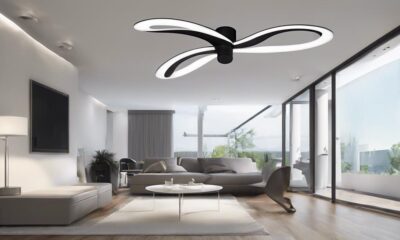
 Vetted2 months ago
Vetted2 months ago15 Best Bladeless Ceiling Fans for Modern and Stylish Homes
-
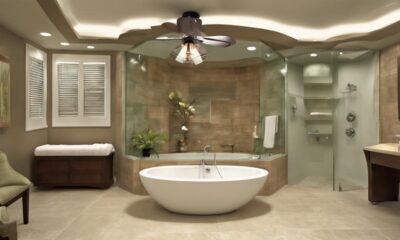
 Guides2 months ago
Guides2 months agoBenefits of Ceiling Fans in Bathrooms
-
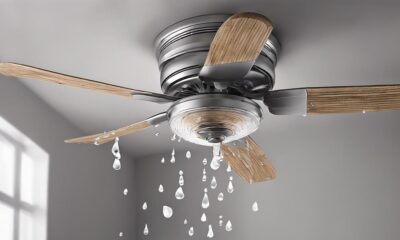
 Guides2 months ago
Guides2 months agoHow to Troubleshoot Water Leakage Through a Ceiling Fan
-
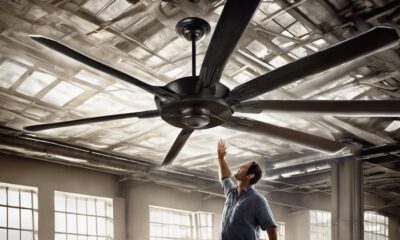
 Guides2 months ago
Guides2 months agoExploring the Worlds Biggest Ceiling Fan
-
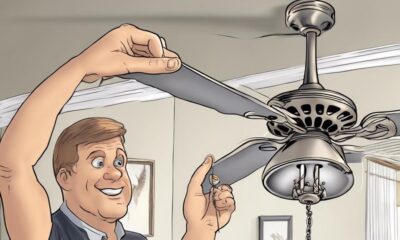
 Guides2 months ago
Guides2 months agoStep-by-Step Guide for Fixing a Stuck Ceiling Fan Pull Chain
-
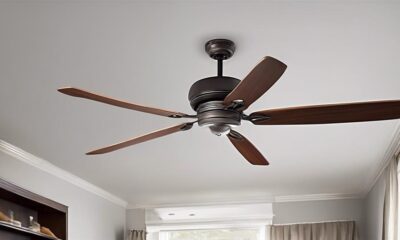
 Guides2 months ago
Guides2 months ago3 Reasons Why a Clicking Ceiling Fan Is Dangerous
-
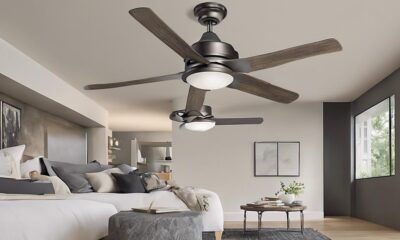
 Guides2 months ago
Guides2 months agoTop 5 Considerations: Flush Mount Vs Downrod Ceiling Fan
-

 Guides2 months ago
Guides2 months agoUsing a Ceiling Fan Correctly to Make Baby Comfortable
